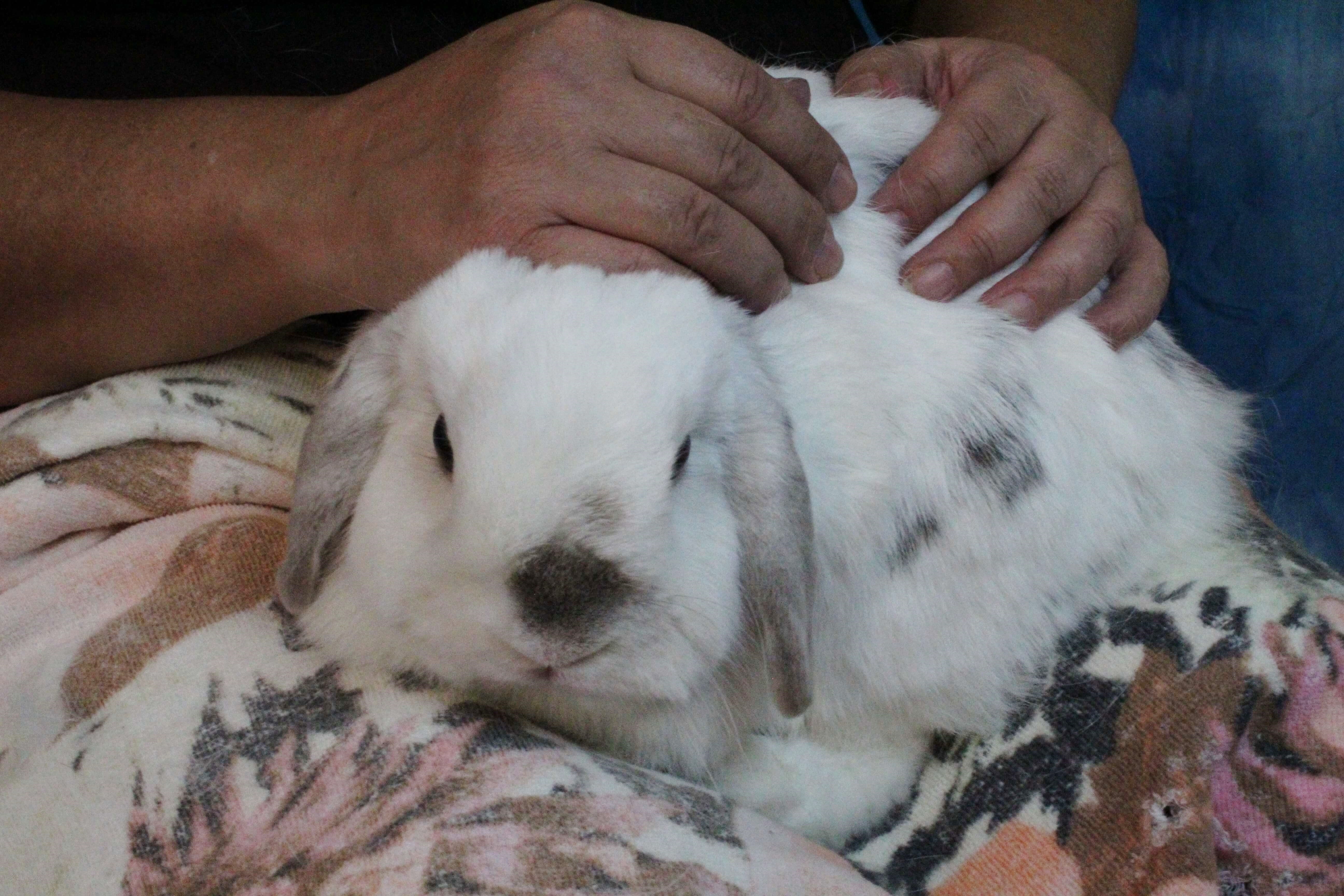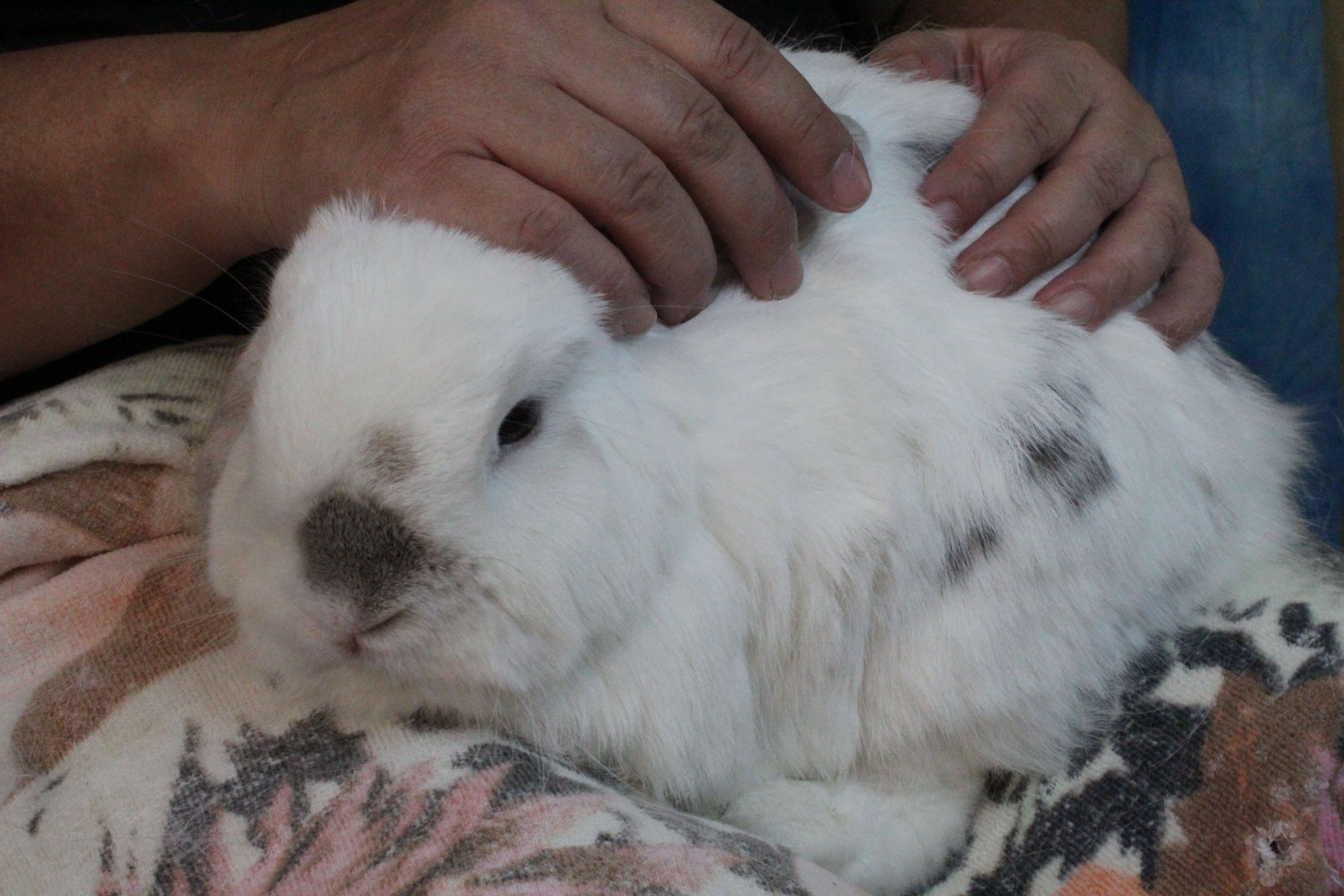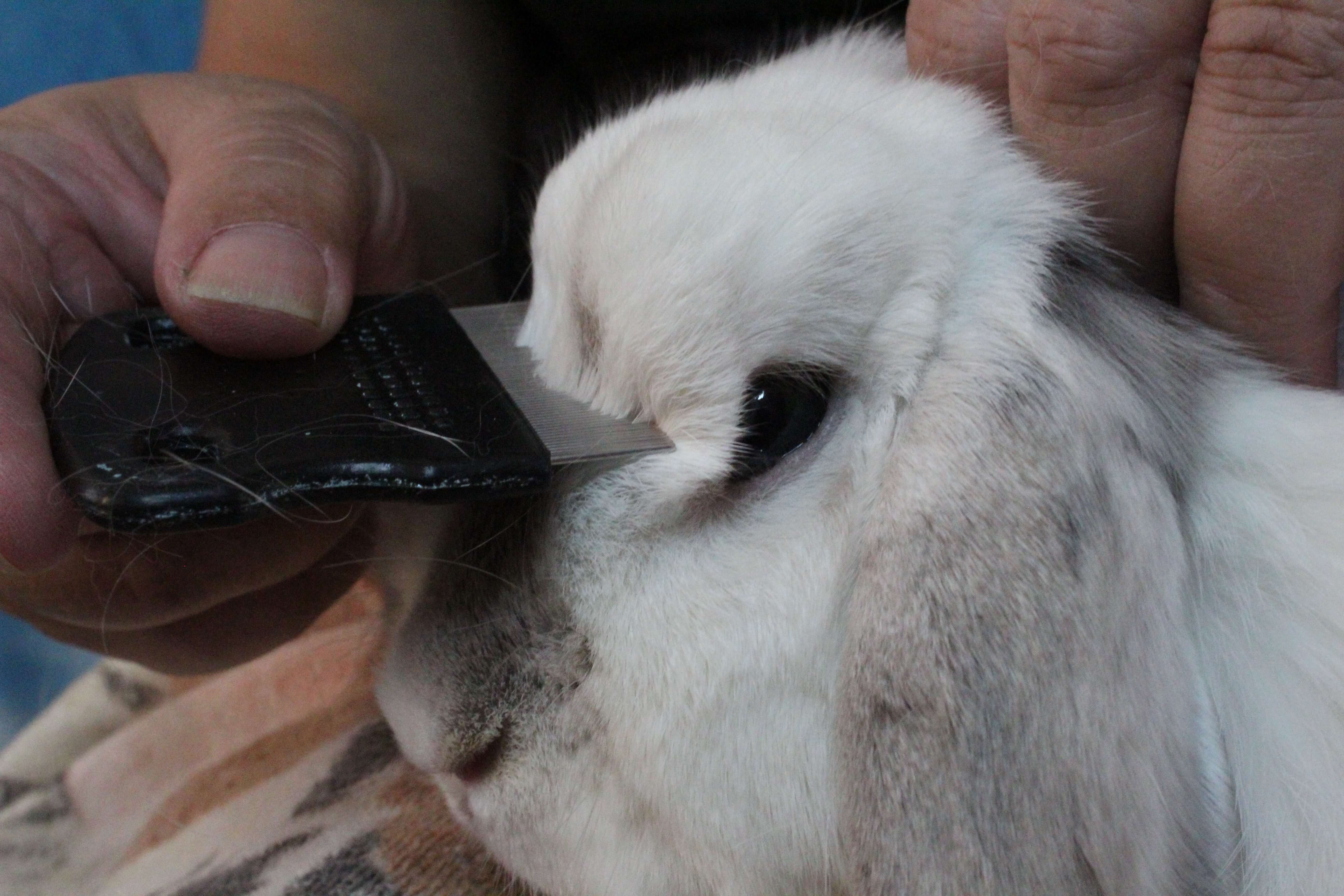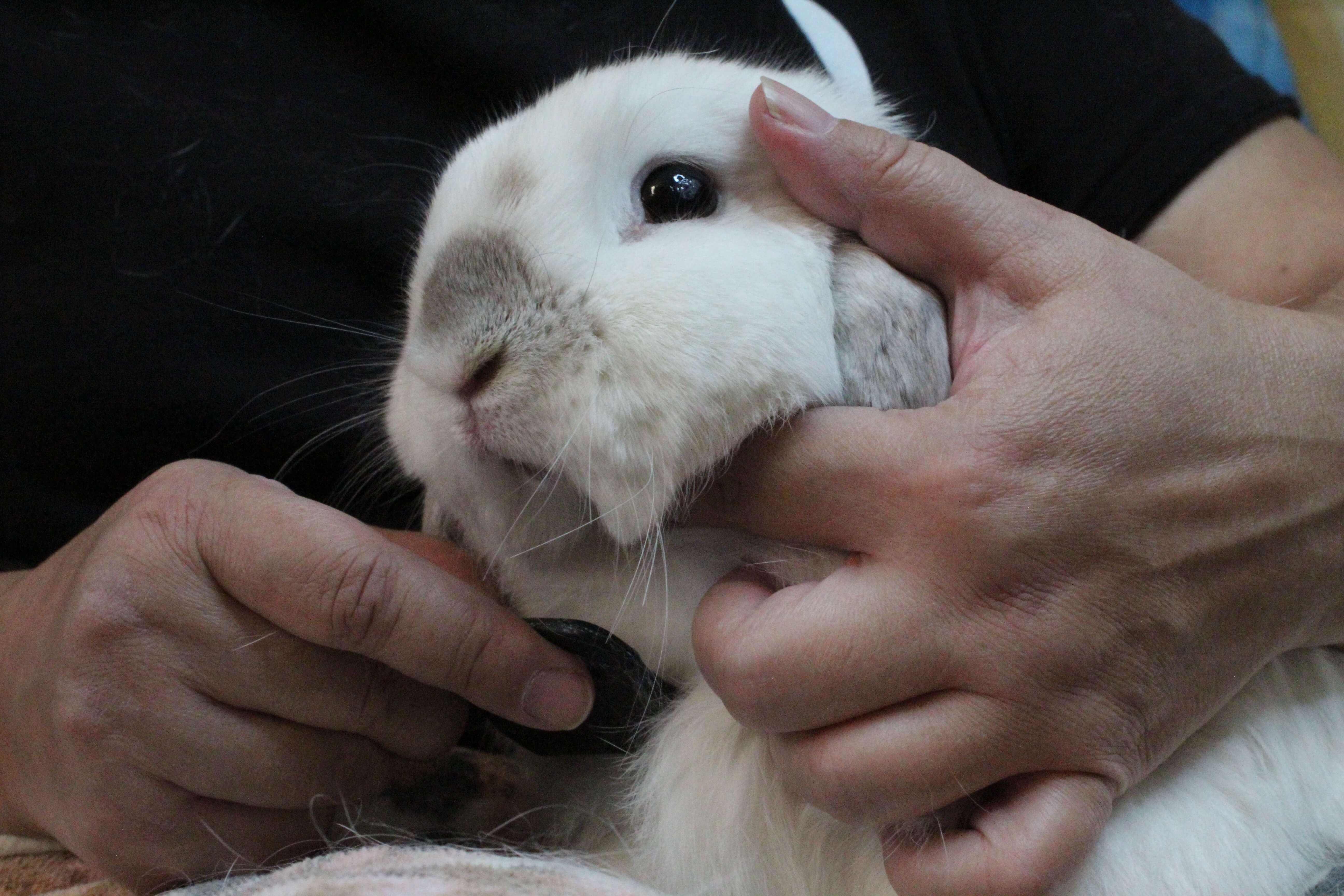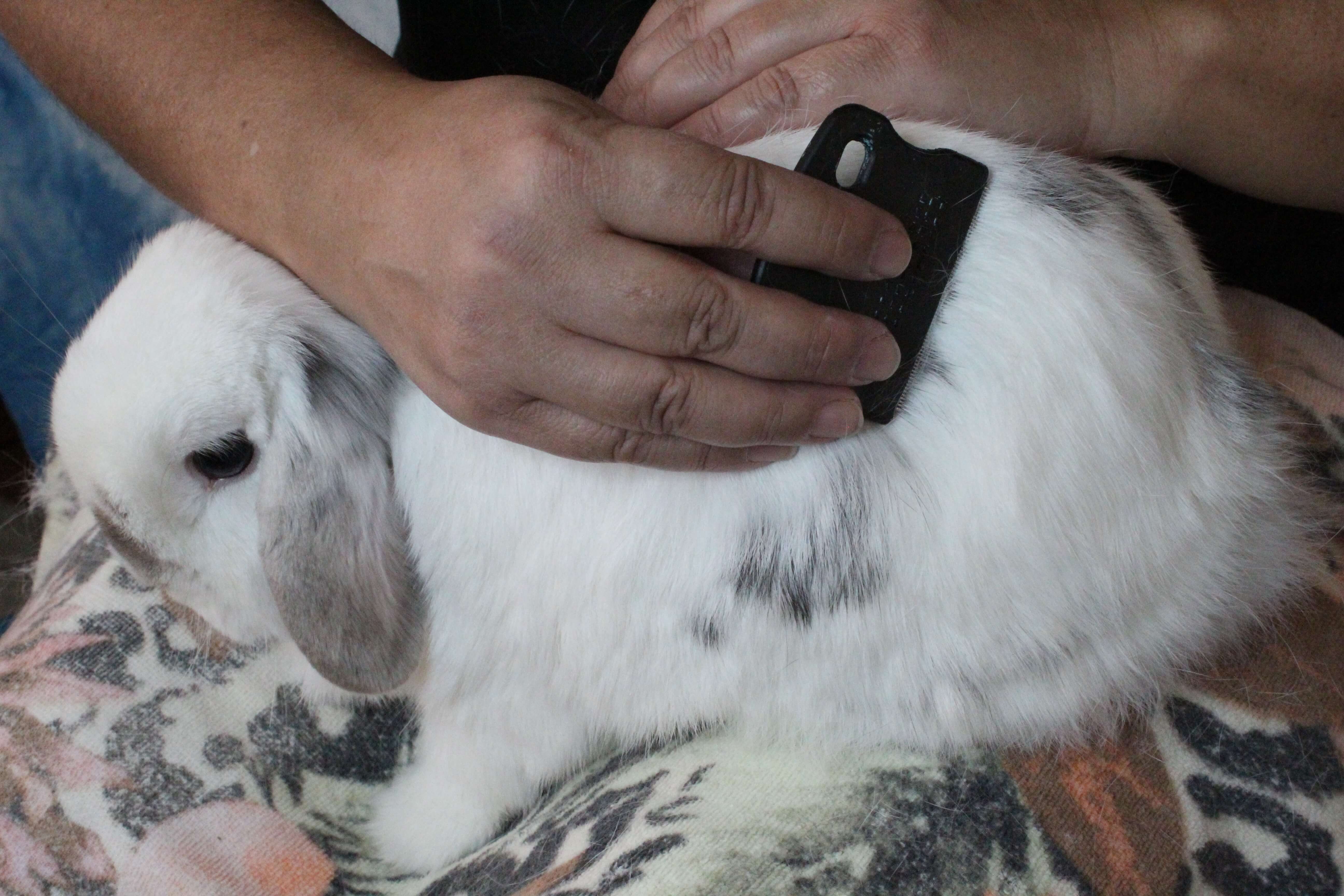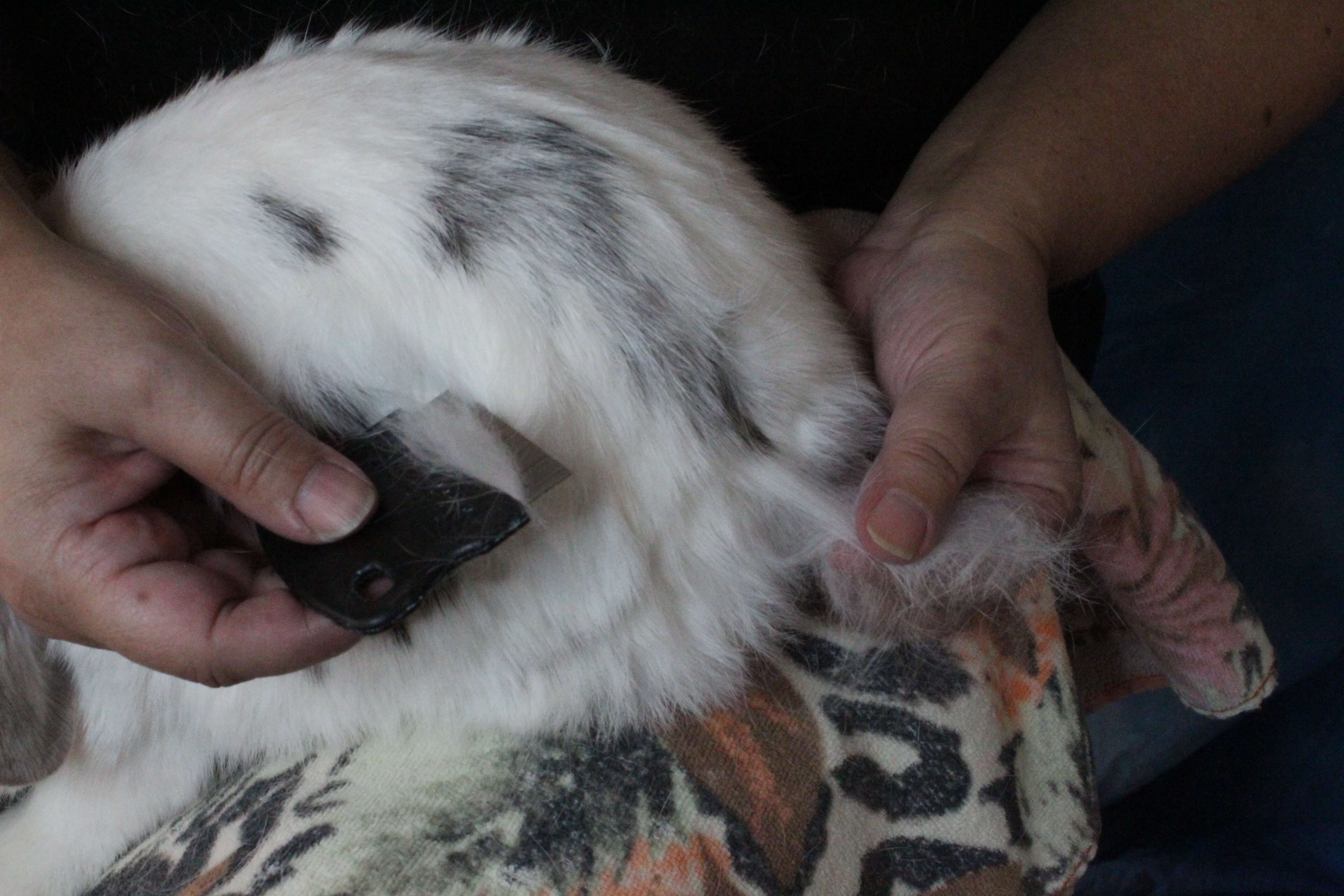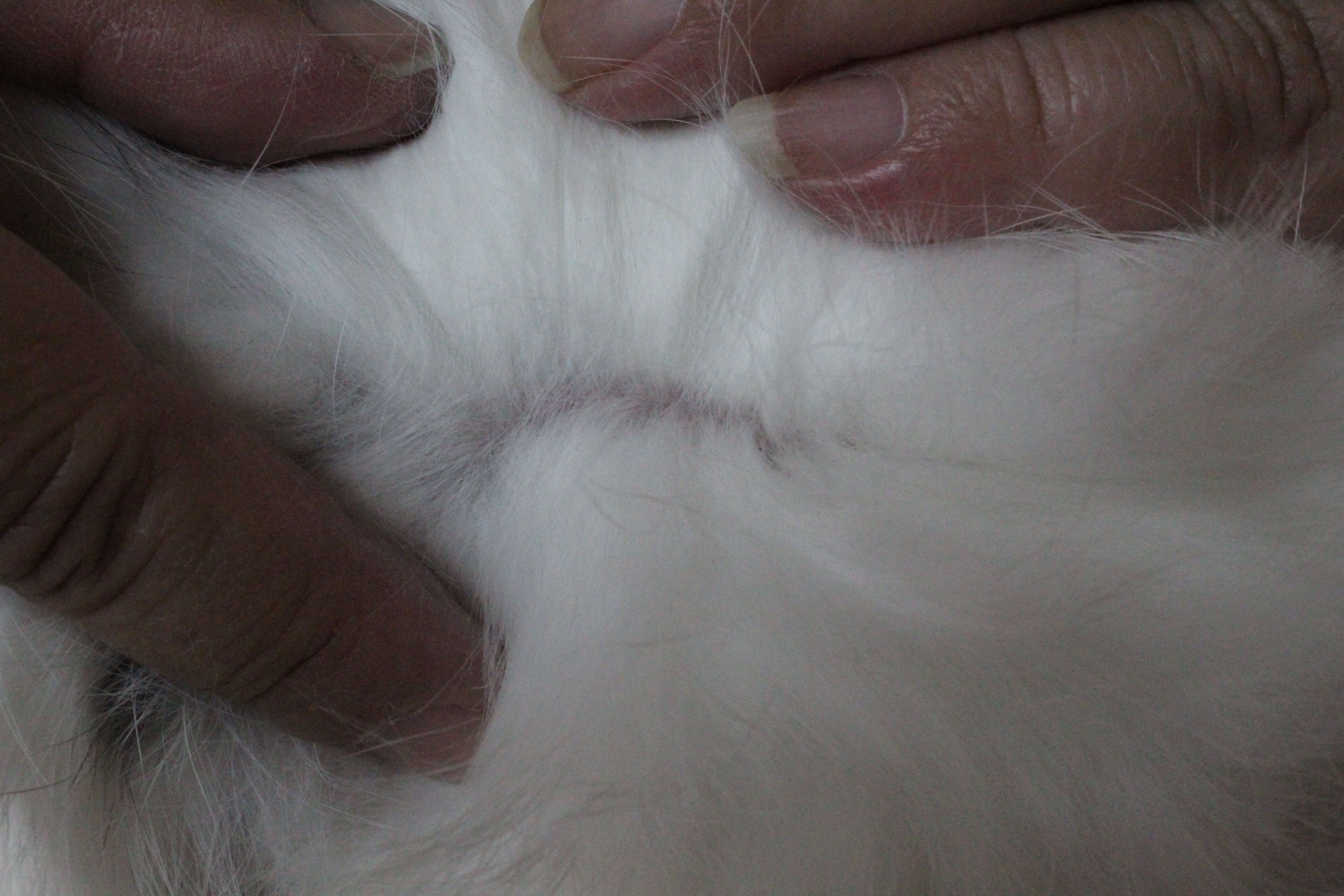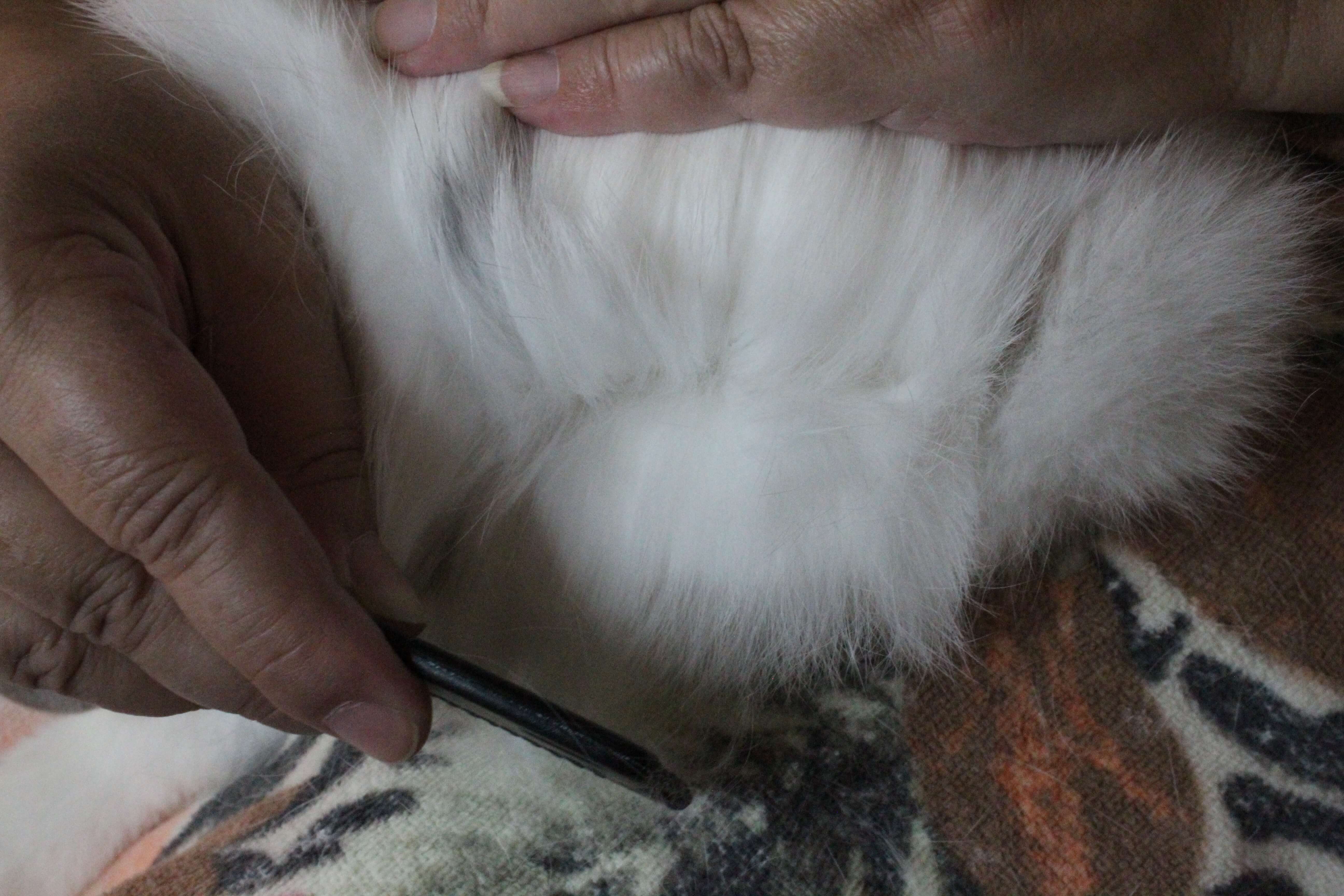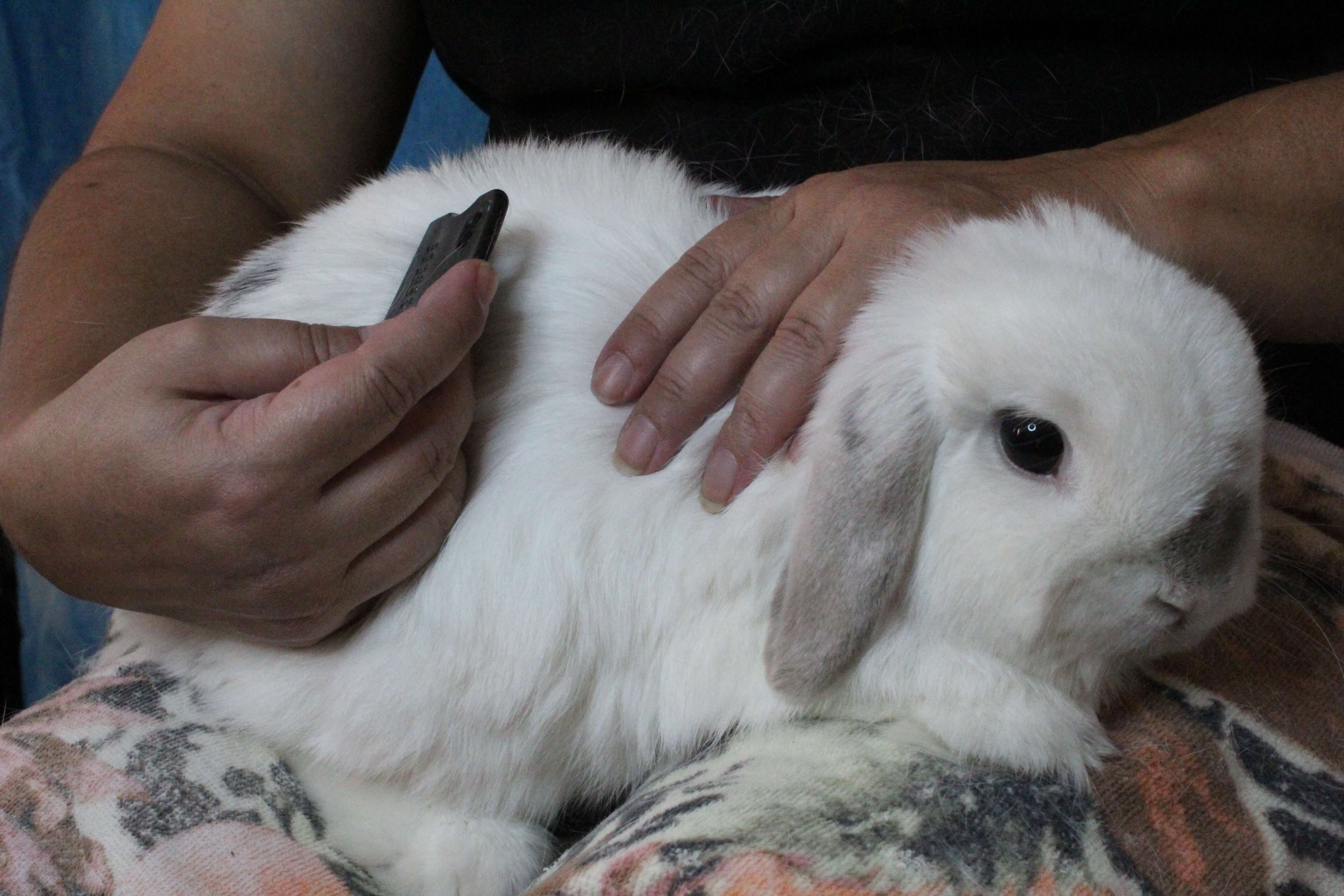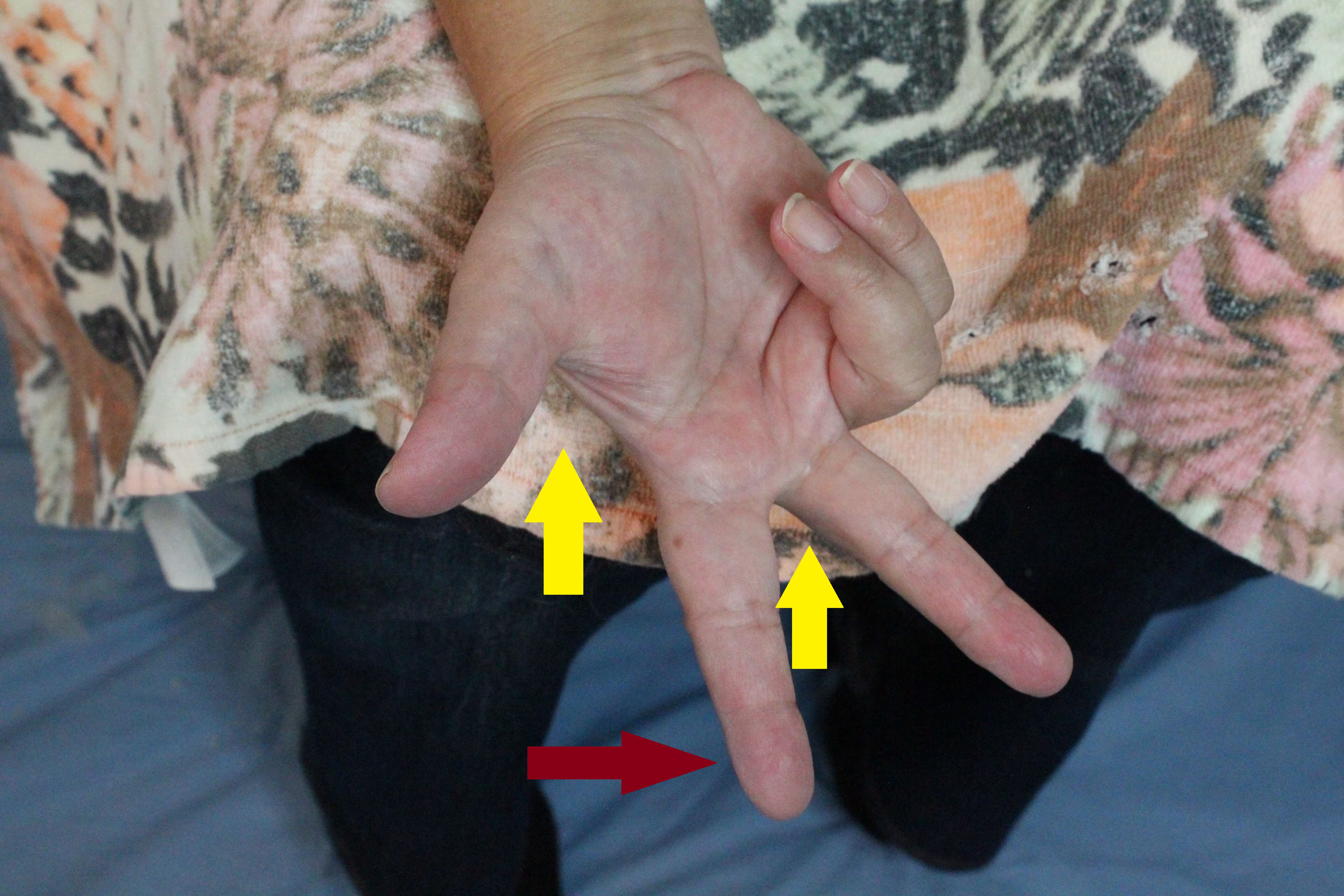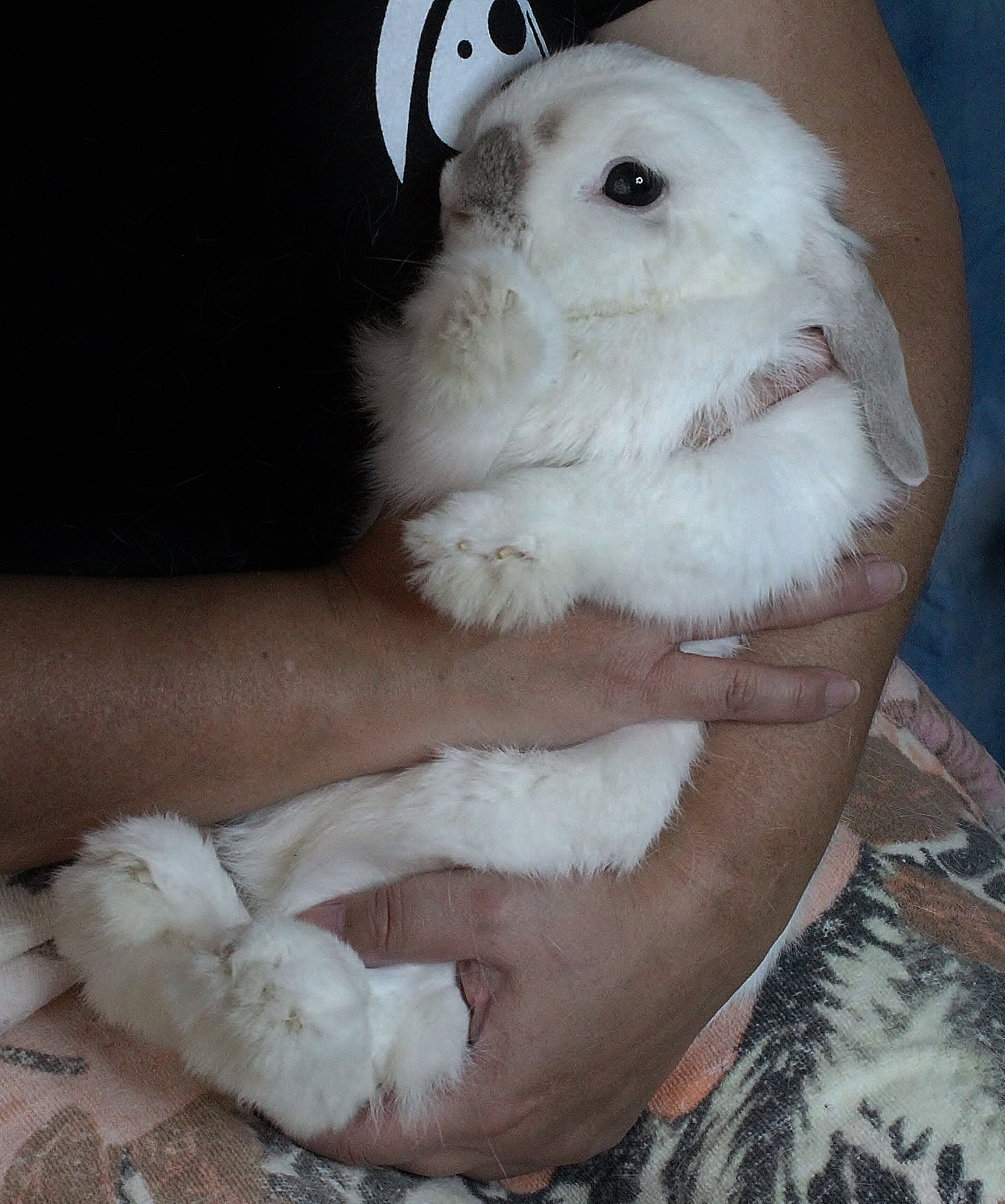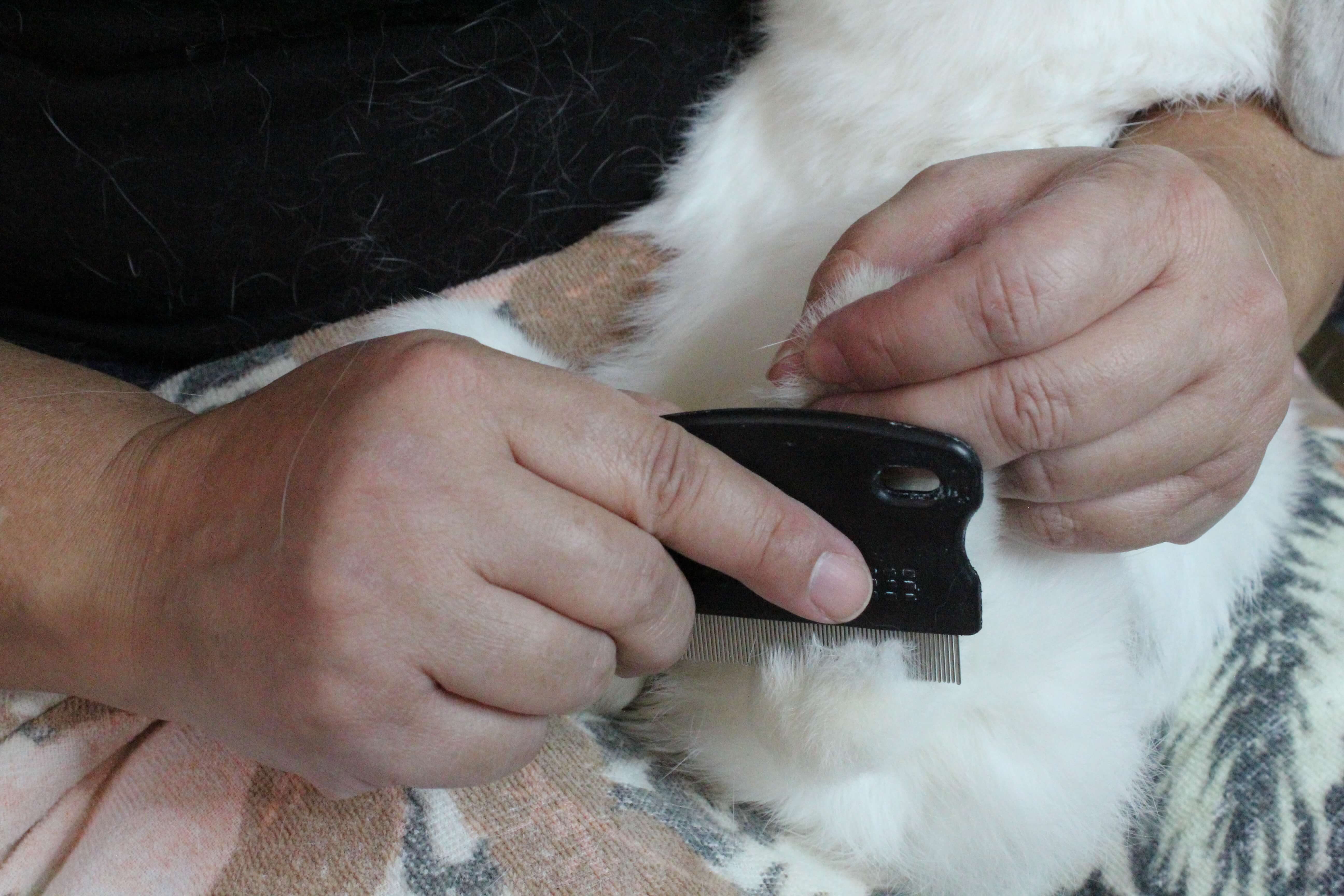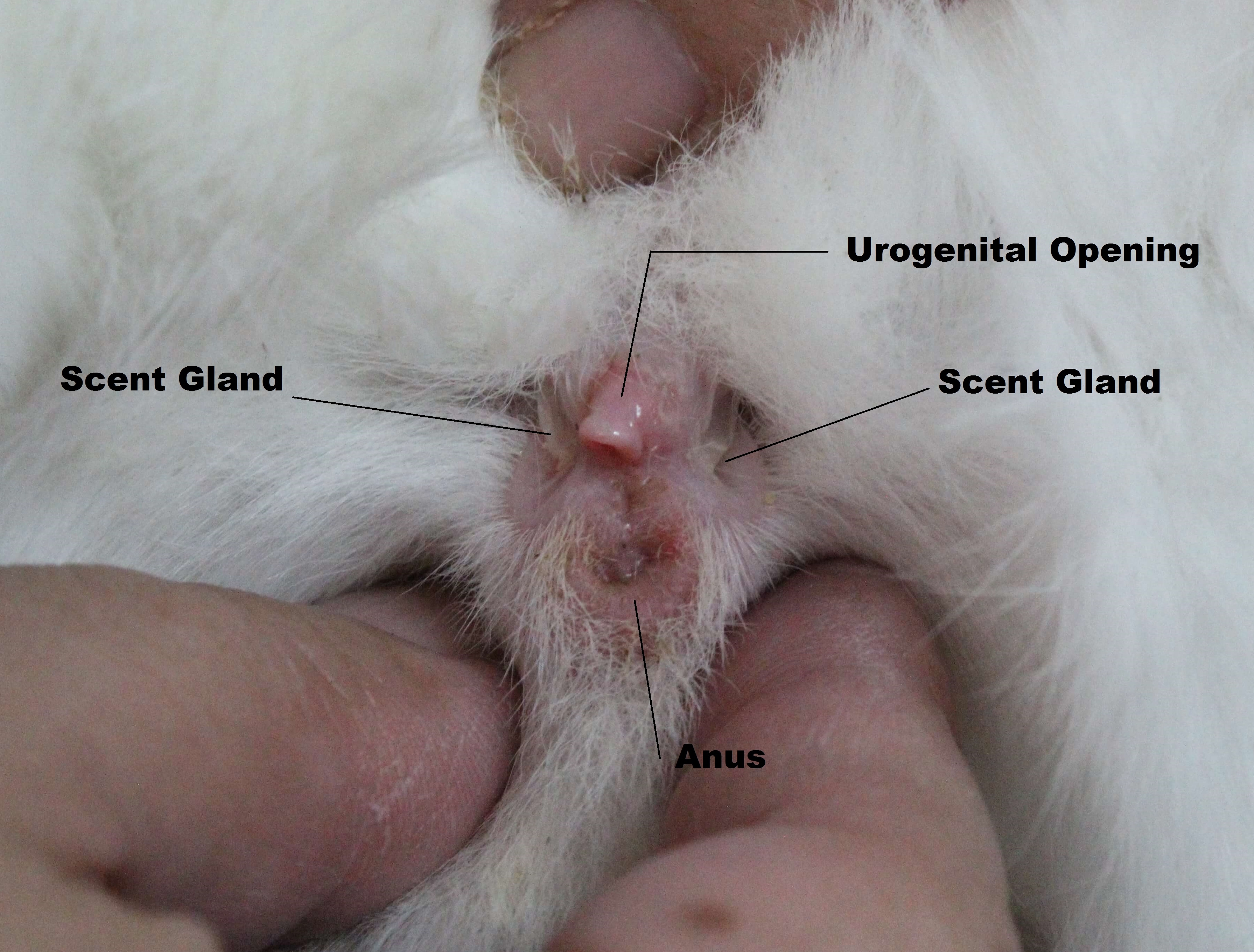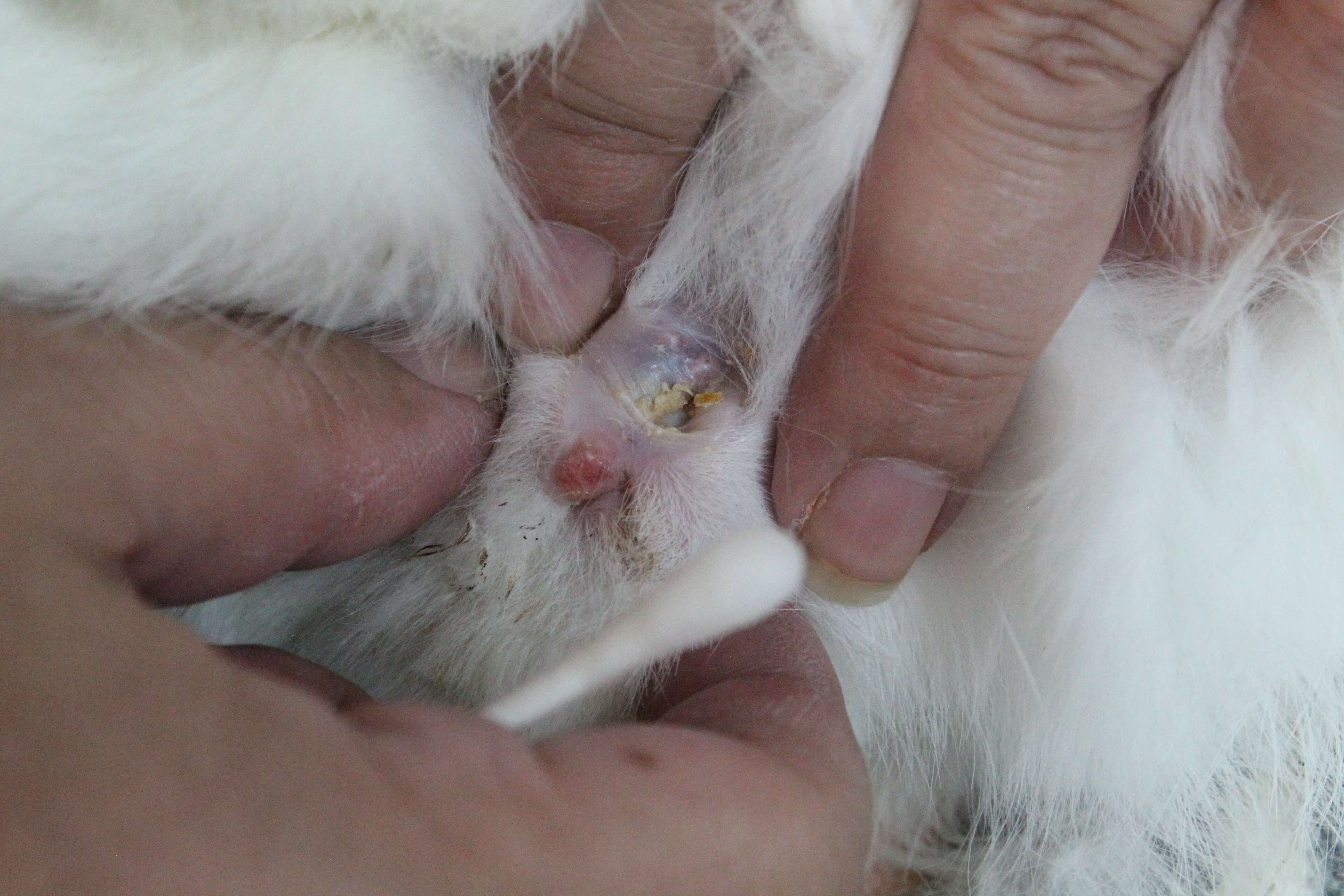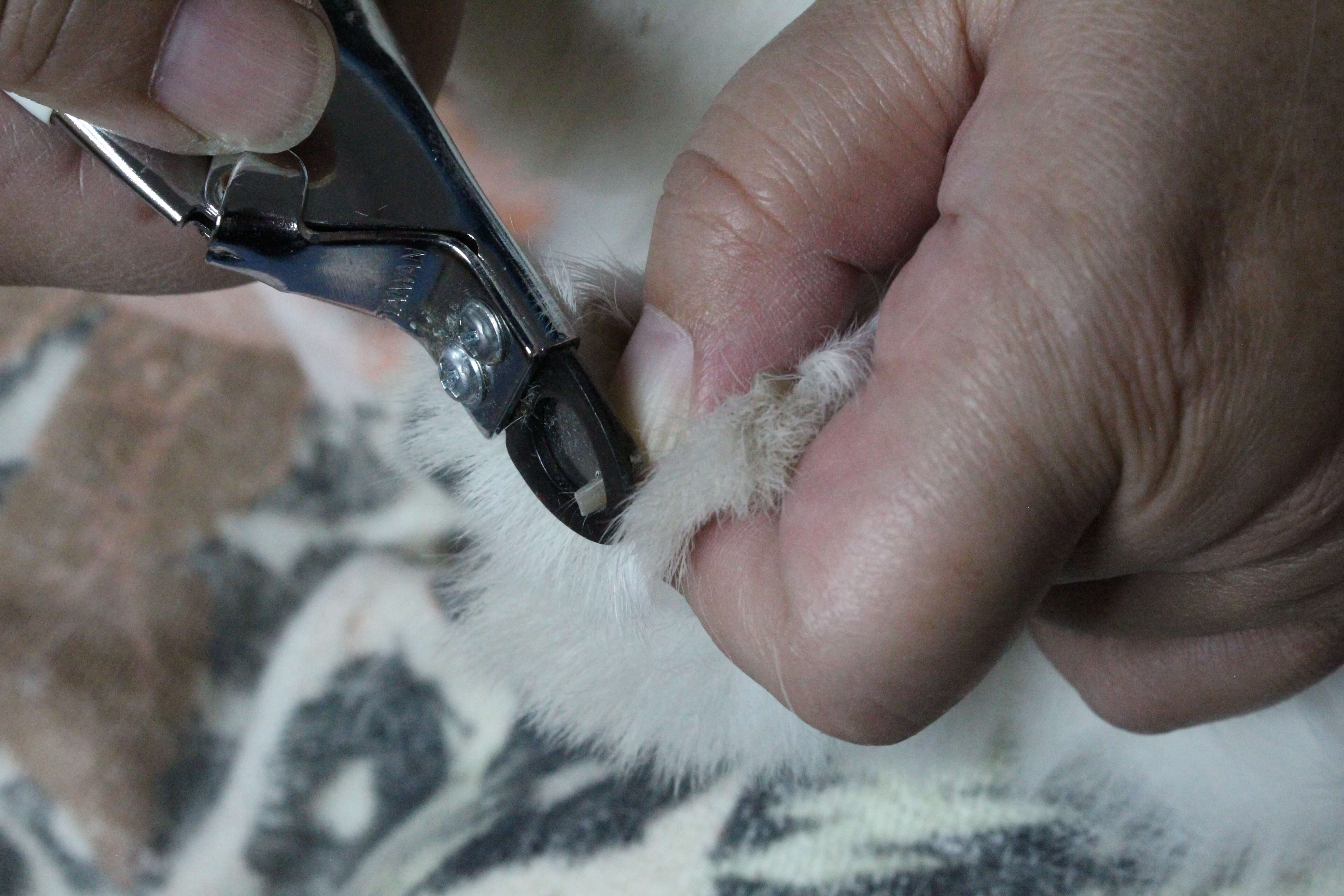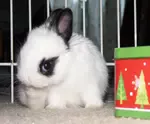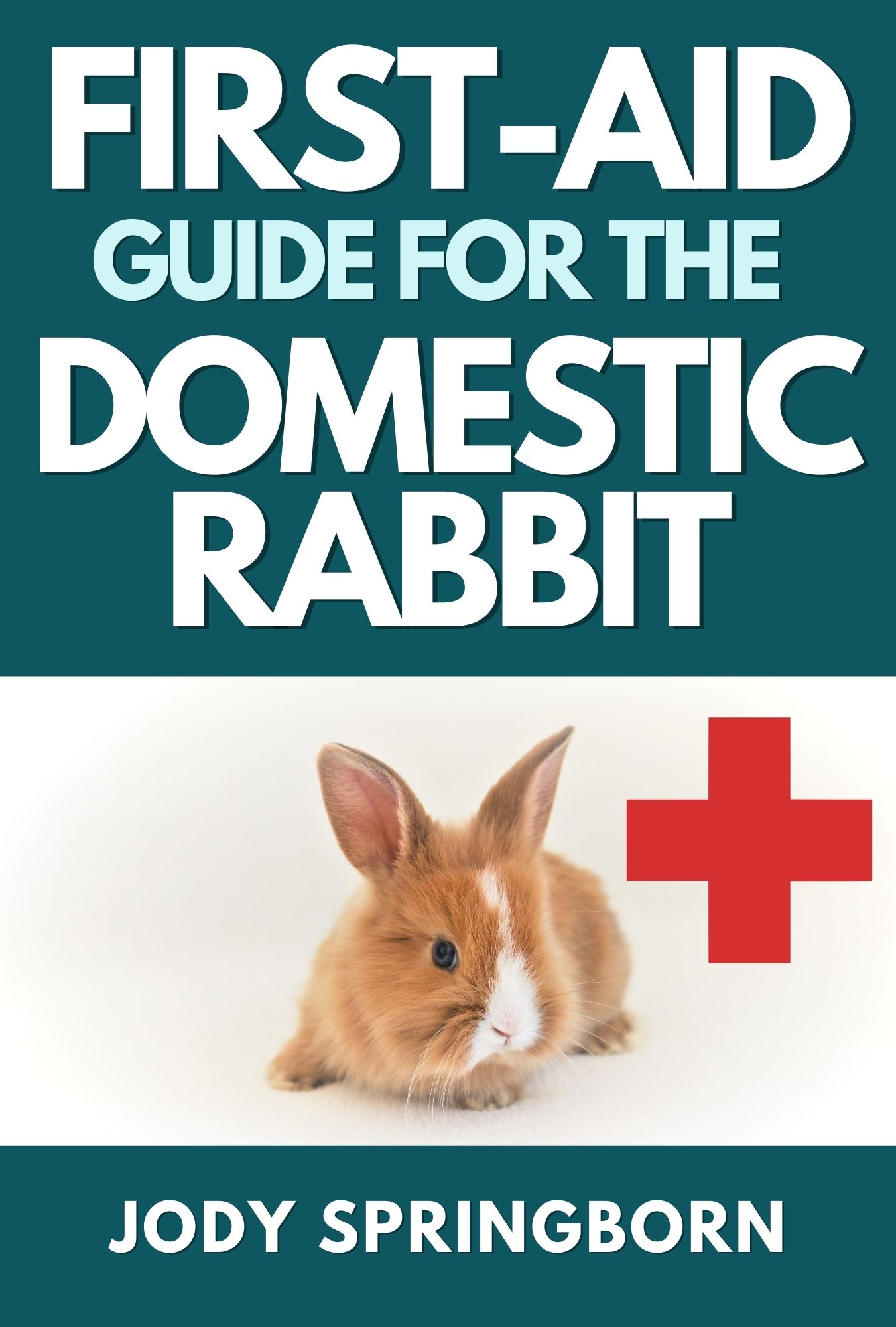- Home
- Grooming Rabbits
Grooming Rabbits
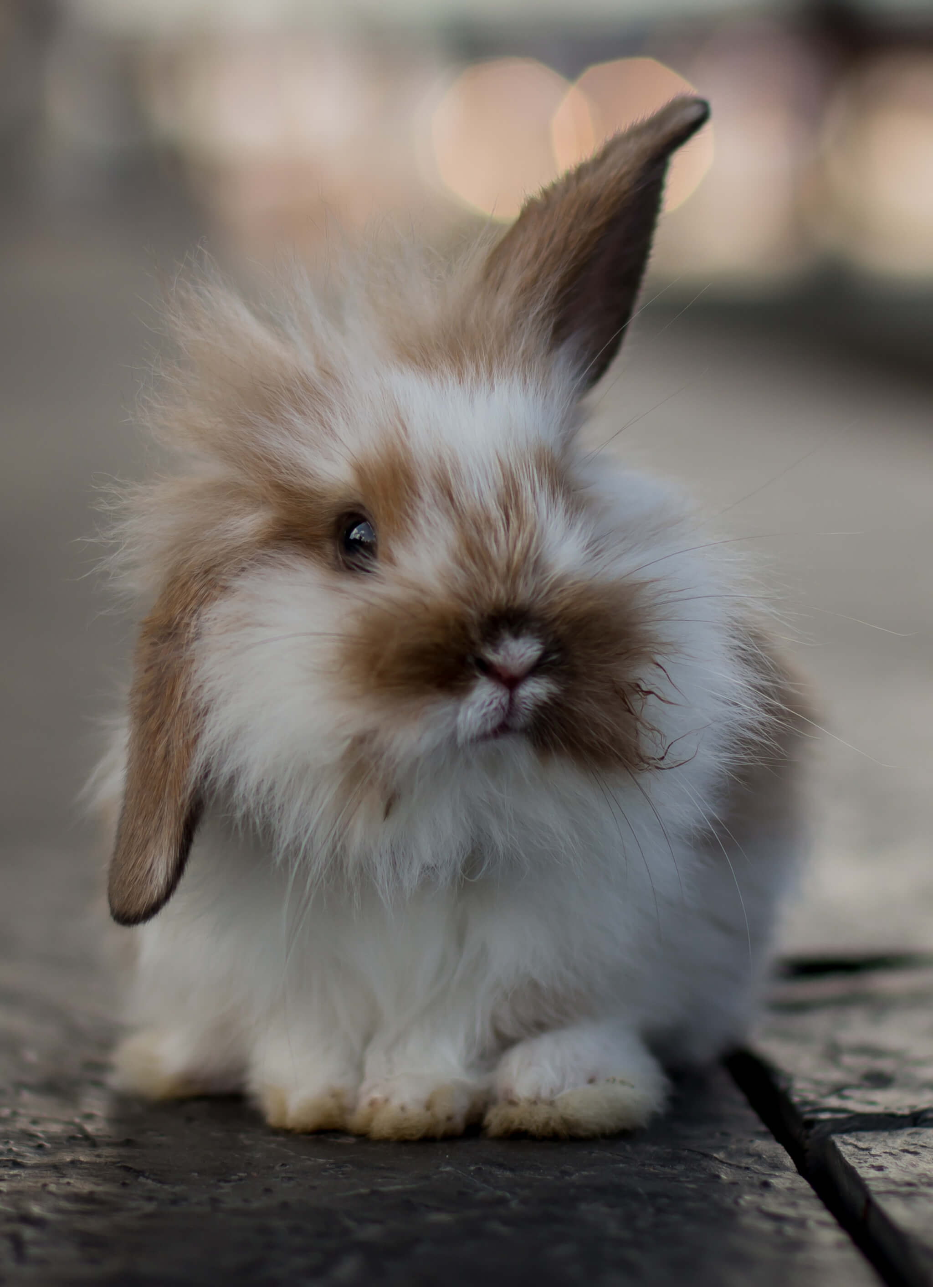 Photo by Tonny de Lasson|Shuttershock.com
Photo by Tonny de Lasson|Shuttershock.comHelp! My House is Furry!
Grooming rabbits is a necessary part of bunny ownership, but many people, especially first-time rabbit owners, are terrified by the prospect. This is understandable, since we've all been drilled from the beginning about how fragile rabbits are and how the slightest mishap can cause crippling injuries.
However, grooming is an essential skill that all bunny owners should learn, as professional rabbit groomers are few and far between. Once you are confident with your handling, your bunny will relax and the grooming session can become a bonding experience between you and your bunny.
Why Grooming Rabbits is Important
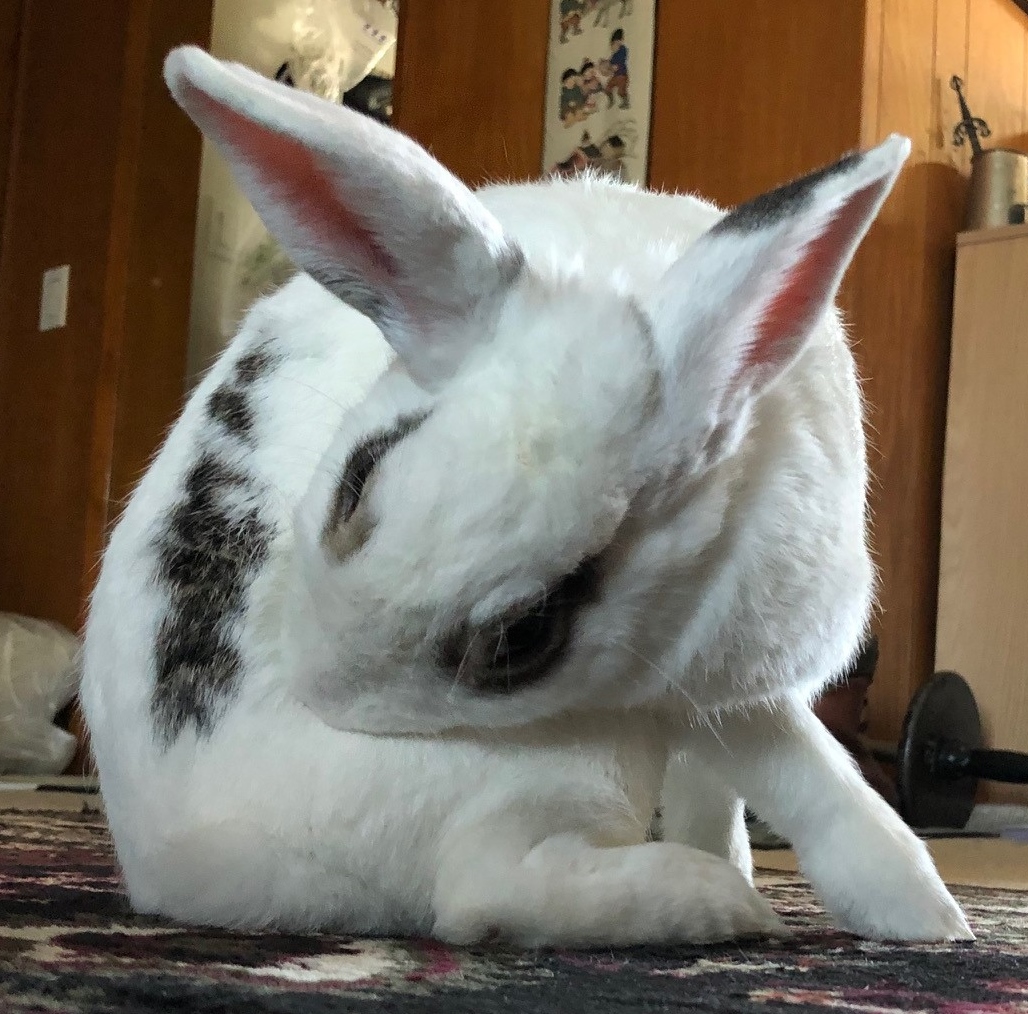 Cupcake making sure he looks good for the camera.
Cupcake making sure he looks good for the camera.Regular combing reduces the amount of loose hair that is on your floor or being swallowed by your bunny. It also allows you to see if there are any parasites, such as fleas, hiding in the coat. Typically, rabbits shed every three months, with every other shed period being a heavy one.
Keeping the nails short prevents the bunny from catching his nails on carpet, rugs, towels and other surfaces. Often, if nails are not trimmed, they catch and break, resulting in bleeding. Also, frequent trimming allows for proper posture. If the nails are too long, bunnies may shift their weight on their feet to accommodate the unnatural bend of their toes. This contributes to more serious problems, such as sore hocks.
Short-haired rabbits, such as Cupcake (above), should be groomed every 8-weeks (at minimum). During a heavy shed, bunnies should be combed out 2-3 times a week.
Long-haired rabbits, such as angoras, require considerably more upkeep. If you want to keep their coat long, these bunnies need to be combed out daily. If this is not possible, these bunnies should have their coats clipped every 4-8 weeks, depending on how quickly mats develop on the individual bunny.
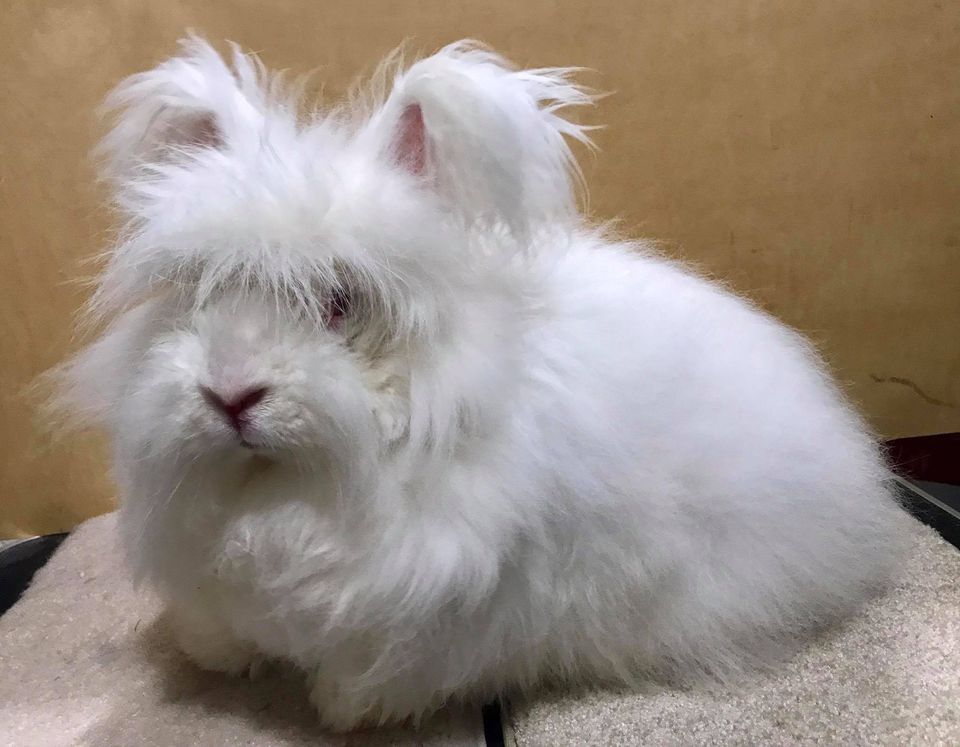 This German Angora requires regular grooming to keep his coat mat-free.
This German Angora requires regular grooming to keep his coat mat-free.Photo courtesy of Greenleaves Angoras
A Word About Hairballs:
It used to be assumed that a rabbit would stop eating and pooping because there was a hairball stuck somewhere in the gut. Research has found that hairballs (or trichobezoars as they are officially known) are the result of GI stasis and not the cause. Rabbits will always ingest a large amount of fur, because they are always grooming themselves. A high fiber diet with adequate hydration will remove the fur from their system efficiently.
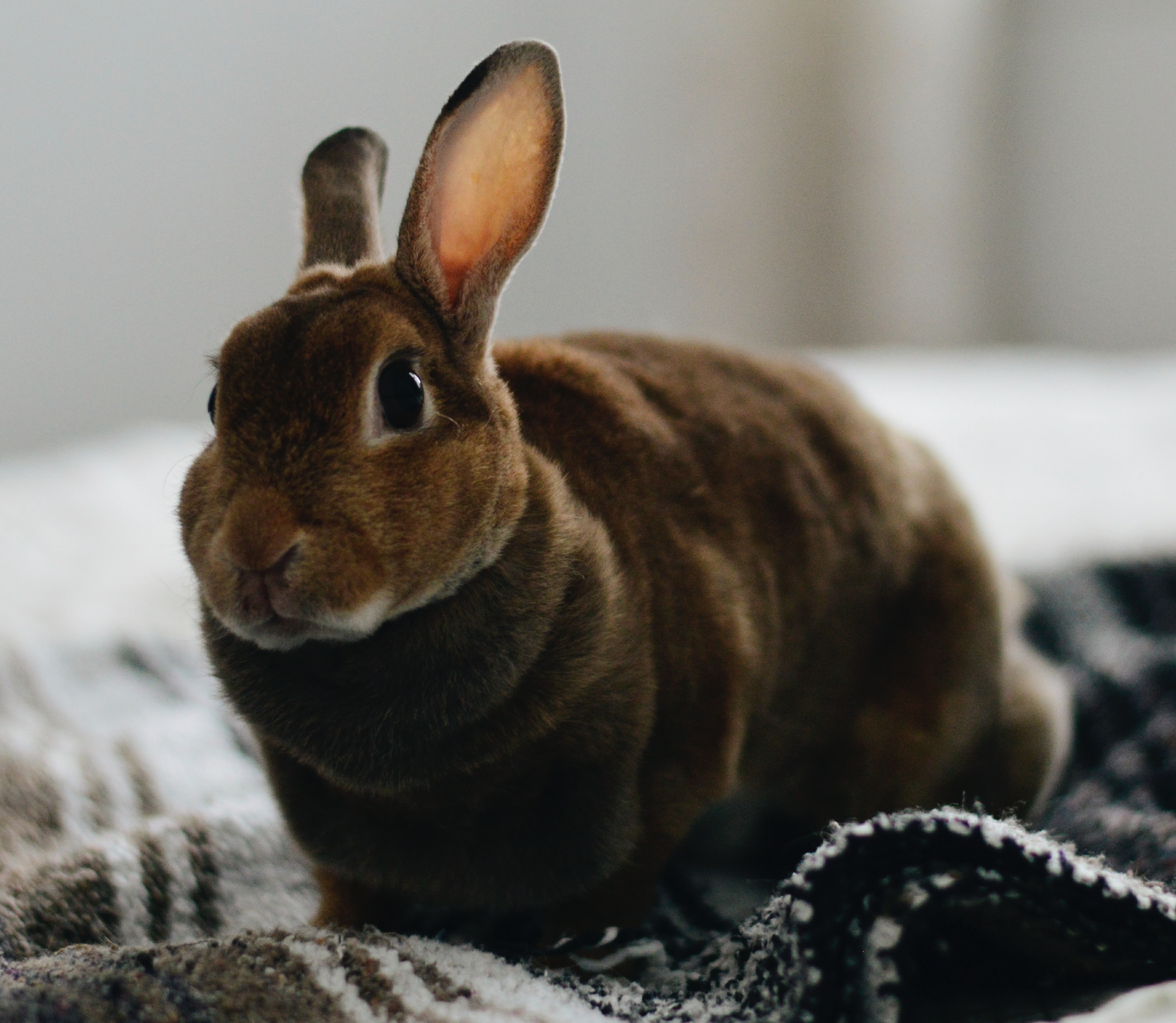 Rex coats have a velvet texture because the undercoat and guard hairs are of equal length.
Rex coats have a velvet texture because the undercoat and guard hairs are of equal length.Photo by Jennifer Chen on Unsplash.
Wellness Checks
Grooming sessions are a good time to give your bunny a head-to-toe inspection to make sure he is healthy. Some things to look out for:
- Ears: Are they nice and pink or crusty (ear mites)?
- Eyes and Nose: Are they clear or is there a discharge?
- Mouth: Is the fur around the mouth wet or discolored?
- Teeth: Are the front incisors even? Molars are difficult to see and need to be examined by a vet.
- Body: Are there any lumps? If there are lumps that have always been there, are they bigger? If the bunny lives with one or more other bunnies, are there any bite wounds?
- Groin: Is the fur around the groin and base of the tail clean?
- Feet: Is there any missing fur on the sole of the foot? If yes, is the skin inflamed, broken or bleeding?
Contact your vet if you notice anything unusual.
Grooming Tools
Combs
Flea combs (far left) are good for removing the undercoat. Combs that have teeth more spaced out are used for long-haired bunnies, like angoras, where they are used to work out knots and mats. The Hair Buster comb on the right is ideal during heavy sheds in removing a great deal of loose hair from the undercoat.
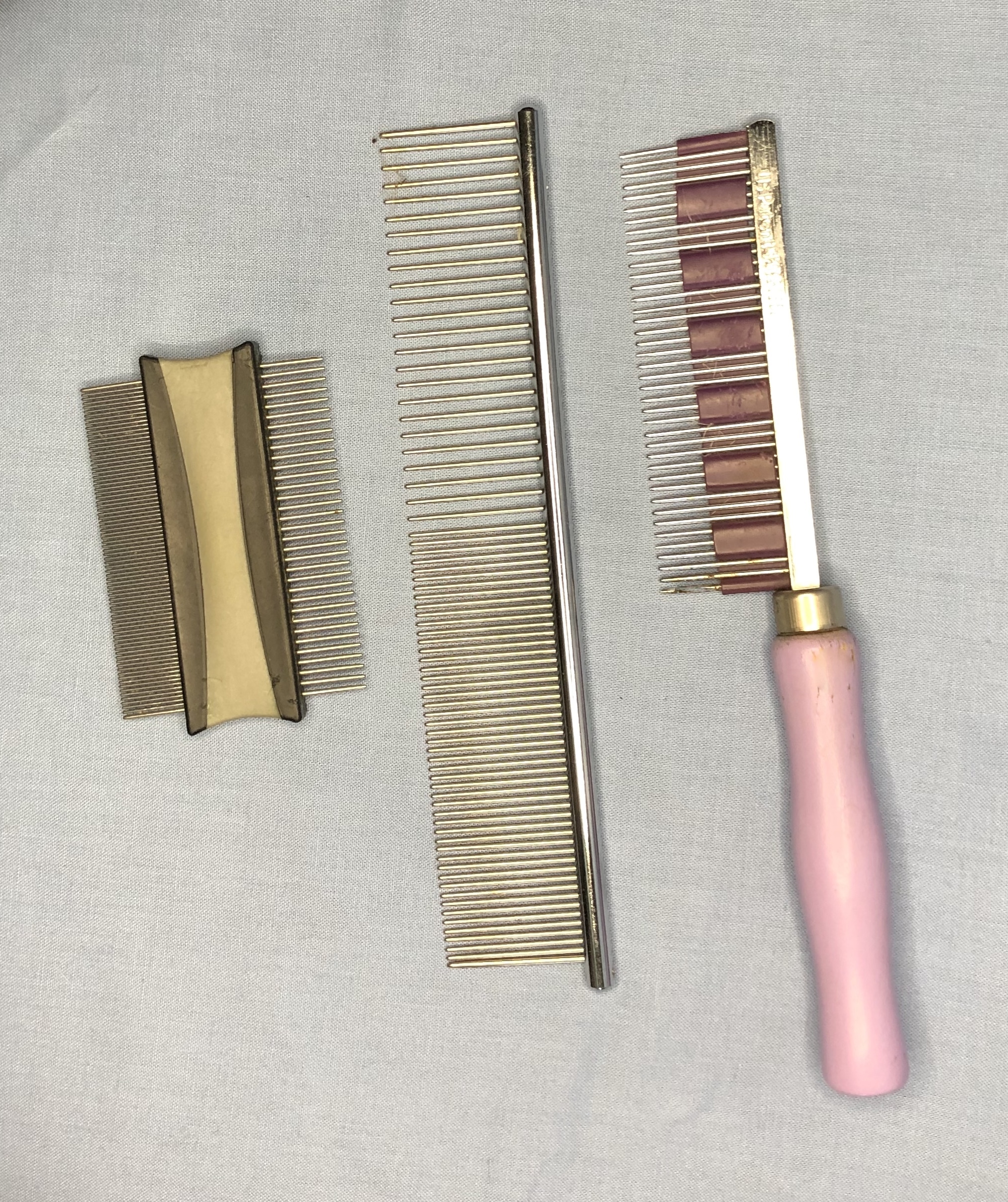 From left to right, flea comb, greyhound comb, hair buster.
From left to right, flea comb, greyhound comb, hair buster.Finishing Brush
This is a soft bristle brush that is good for getting that "halo" of loose fur that sits on top of the coat. It's used at the end of the grooming session, and most bunnies seem to enjoy being brushed from nose to tail. Alternatively, you can use a grooming glove or wet your hands and run it along your bunny.
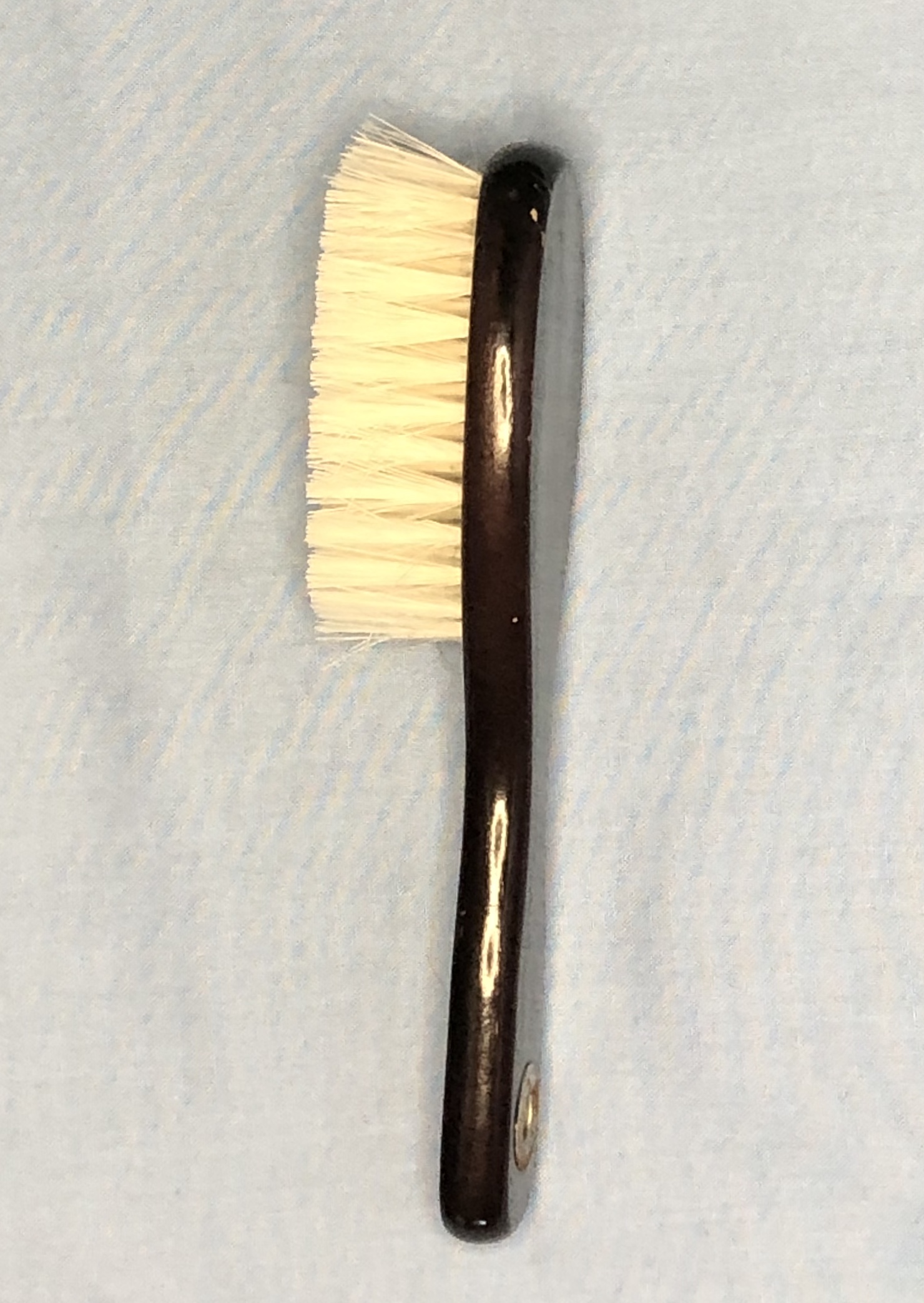
Scissors
For typical short-haired grooming, a small pair of blunt-nose scissors will do the job. The small size and rounded tip will make sure you safely trim away mats. The larger pair is more helpful if you need to trim a big section of fur, such as on an angora.
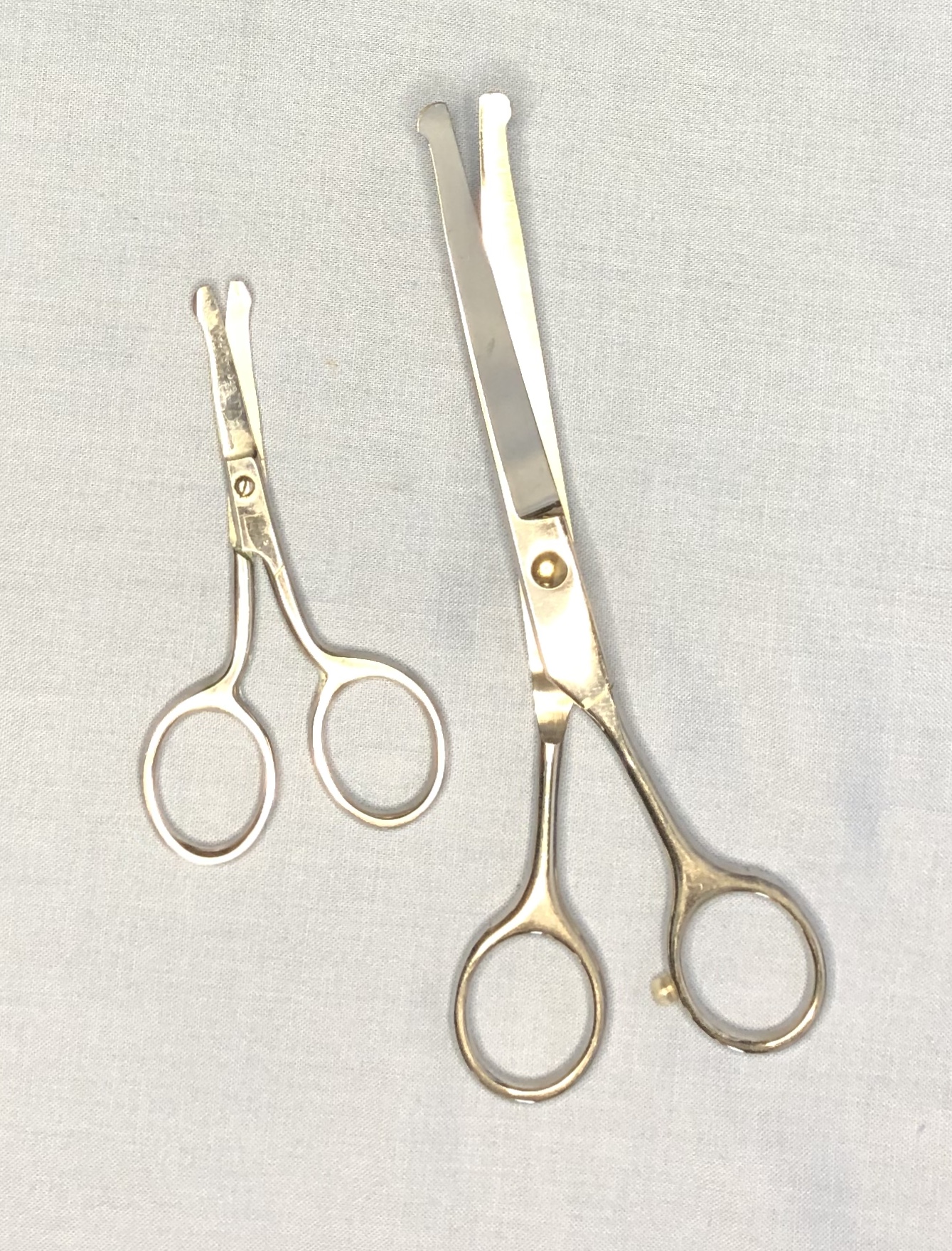
Small Trimmers
Small pet clippers or hair trimmers for men are small enough to trim the fur in the groin area, should your bunny need it. It's good for the occasional spot trim and safer around the groin than scissors, especially if your bunny kicks a lot during grooming sessions. These clippers are cheaper than regular grooming pet clippers, however, they are only good for small, hard to reach places like the groin.
If you are trimming a long-haired rabbit, you want to invest in high-quality pet clippers.
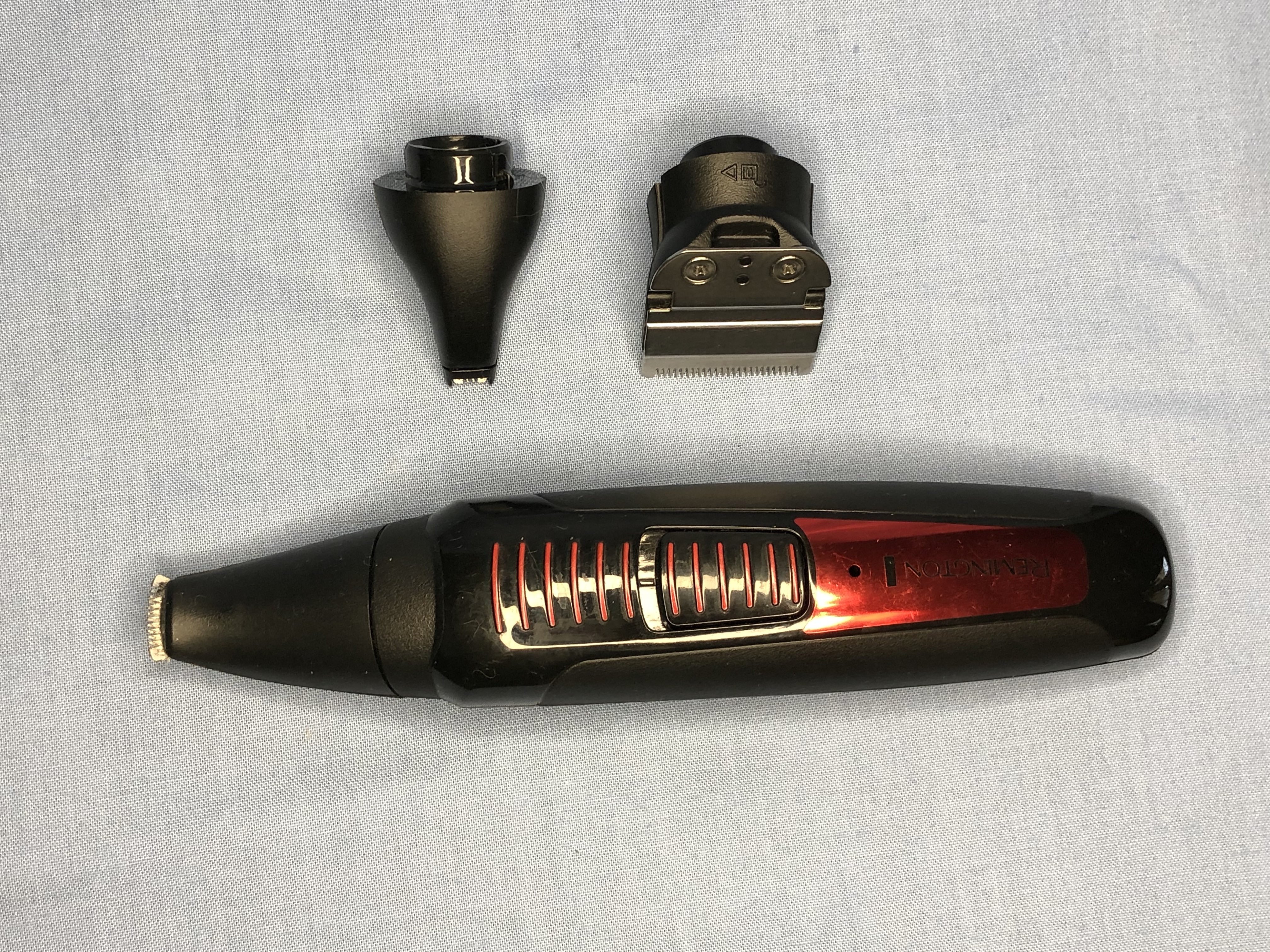 Hair clippers and trimmers for men are the perfect size to get into very hard to reach places.
Hair clippers and trimmers for men are the perfect size to get into very hard to reach places.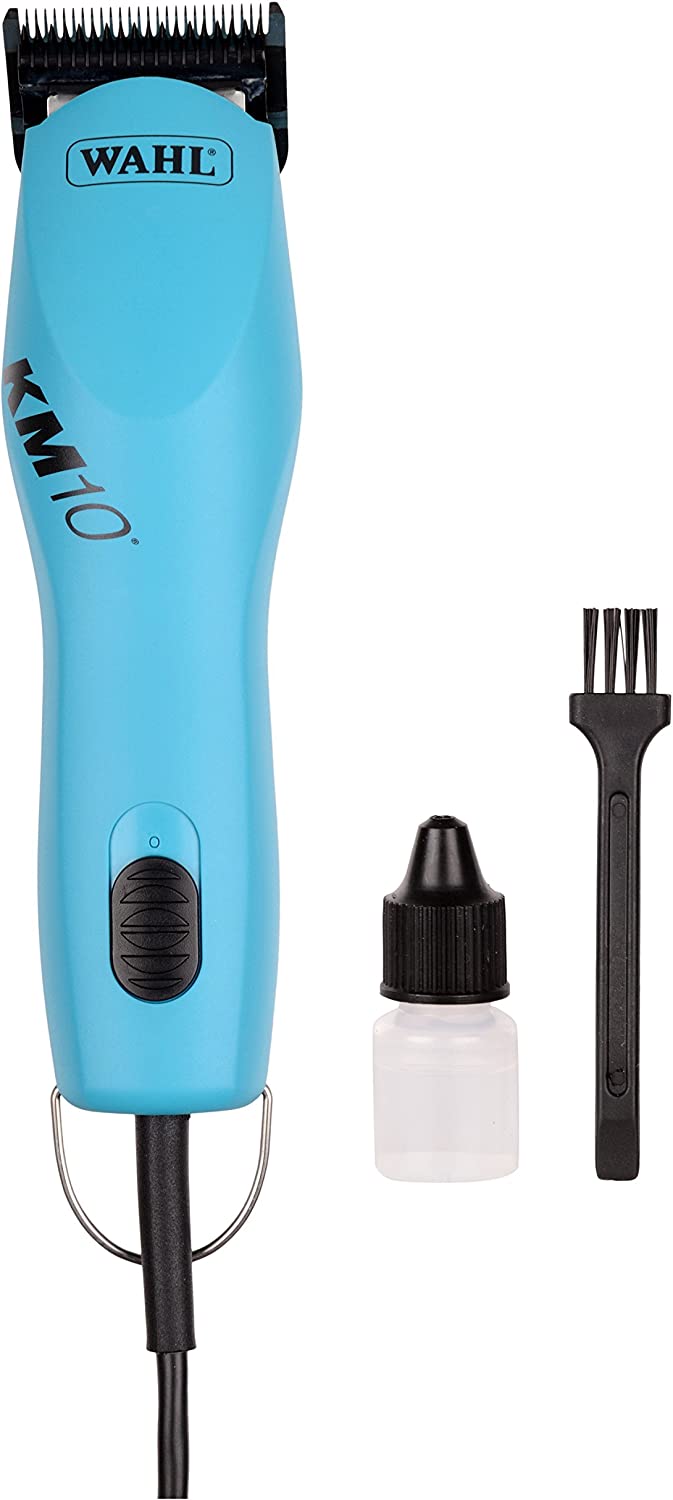 Wahl KM10 Clippers
Wahl KM10 ClippersNail Trimming Tools
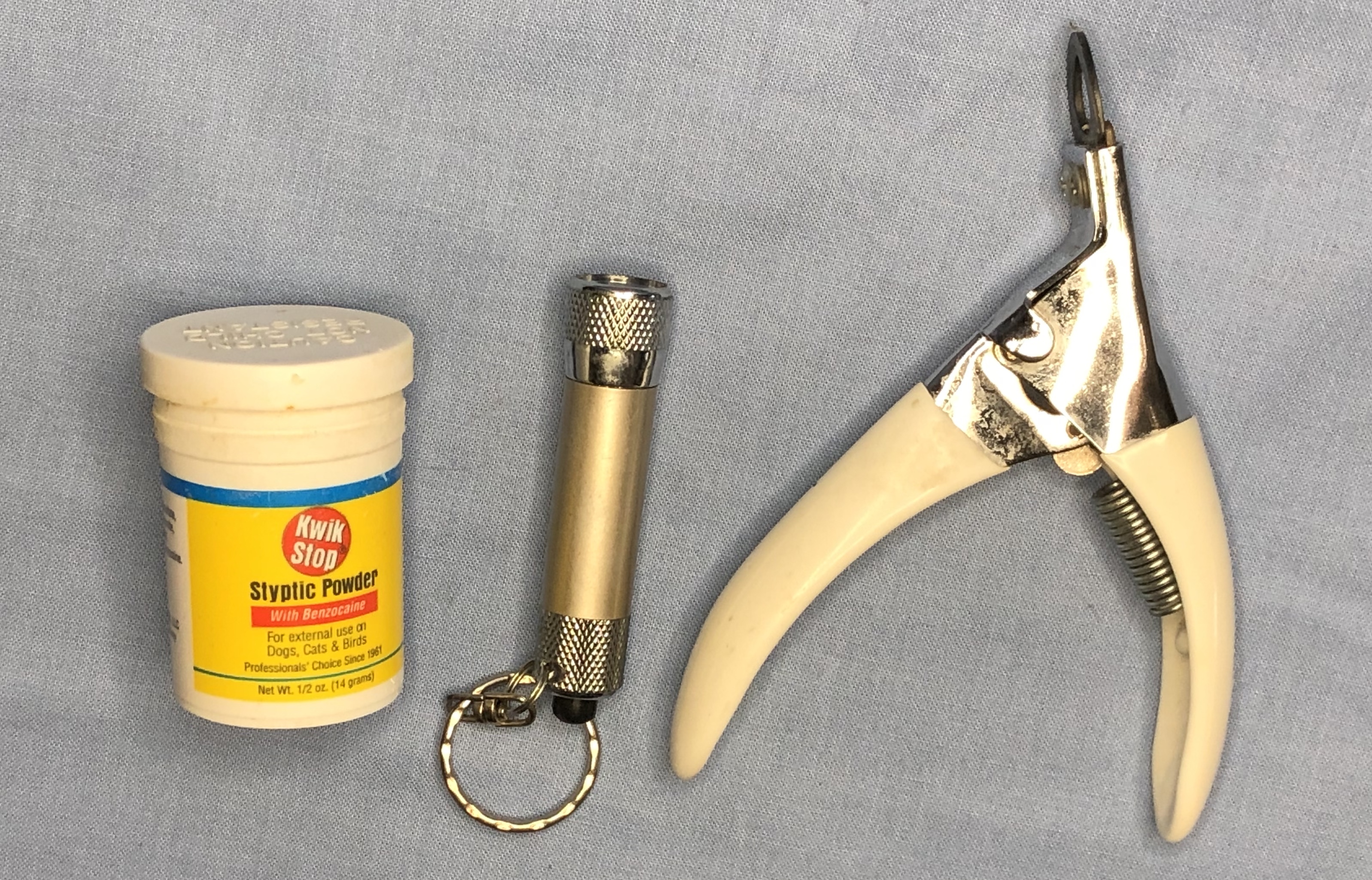 From left to right: Styptic powder, LED light and guillotine-style nail trimmers
From left to right: Styptic powder, LED light and guillotine-style nail trimmersThere are two styles of nail trimmers - clippers (they work like scissors) and guillotine-style. People usually develop a preference for one style or another. I prefer guillotine because it tends to give a nice, clean cut. However, I will use the other style if a nail is really curved in towards the paw.
A LED pen light is invaluable for illuminating the quick (the vein in the nail), especially in dark nails. Styptic powder is used to stop the bleeding if you happen to cut into the quick. However, in a pinch, you can also use flour or cornstarch. Never use styptic powder on any wound other than nails, as it can damage tissue and delay healing.
A nail file (or emery board) is also helpful to have on hand. It's easier and safer to just smooth away a rough or sharp edge that is near the quick, rather than try and remove it with the clippers.
Tools to Avoid
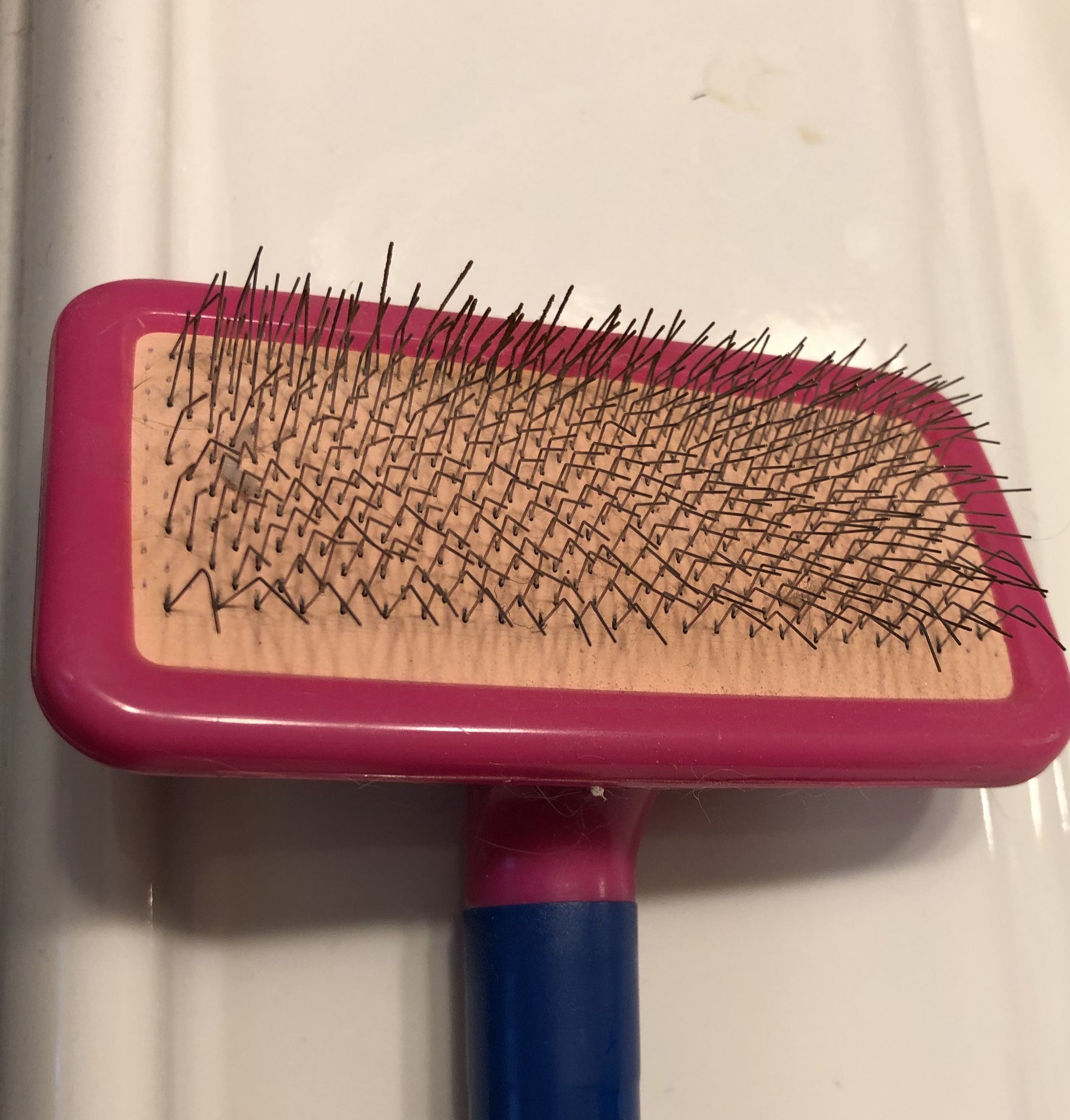 Slicker brush
Slicker brushSlicker brush: I'm not a big fan of slicker brushes, mostly because I stab myself under the fingernails while removing hair. Rabbits have very delicate skin. Brushes with sharp, metal bristles can easily cause bleeding. It's better to tease out mats with a comb or cut them out with scissors.
Grooming gloves: Many owners have these gloves and it's a good way to get rid of the haze of fur that floats on top of the bunny during a heavy shed AND you get to pet your bunny at the same time. However, it doesn't get rid of the undercoat. For that, you need to use a comb. You can use the gloves in place of the finishing comb.
FURminator or similar tools: I have tried the FURminator and tools similar to it. I find it doesn't rid the undercoat very well and you need to be very careful as to not scratch your bunny's skin. Here again, the flea comb or Hair Buster comb is more effective in removing loose fur safely.
Grooming Rabbits 101
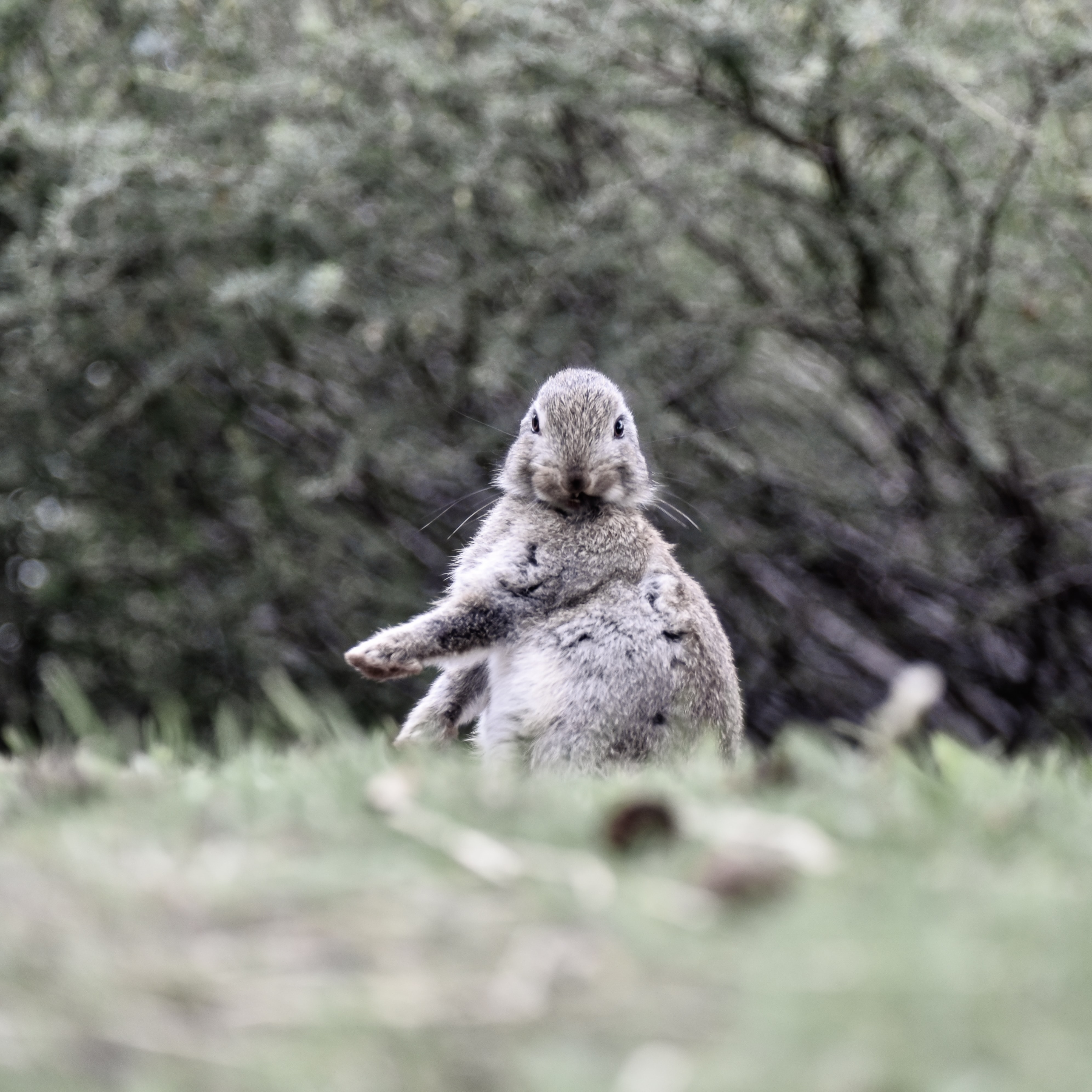 Wild rabbit taking a moment to groom himself.
Wild rabbit taking a moment to groom himself.Photo by Irina Babina on Unsplash.
Many owners find grooming rabbits challenging, especially when the bunny is constantly looking for a way to escape. The best way to minimize this is to choose a neutral space to groom. This is usually the bathroom. Avoid grooming on a couch, floor or bed as it doesn't take much effort for a bunny to escape your grasp and take off. When the bunny is on your lap, table or counter, he is usually more reluctant to jump down. Always have your bunny stand on a folded bath towel. It makes a nice "floor", and your bunny's feet don't slip from underneath him.
Be confident in your handling. If you are hesitant, nervous or don't hold your bunny securely, the bunny will pick up on your insecurity and look for a way out. The more sure you are with your handling, the calmer your bunny will be and the easier the grooming task.
Typically, a short-haired grooming session should take about 30 minutes - longer if your bunny is in the middle of a heavy shed or needs a butt bath. Beginners may want a partner to help hold the bunny while they groom. However, once you are comfortable in your handling, most tasks can be accomplished by one person.
Shed Patterns
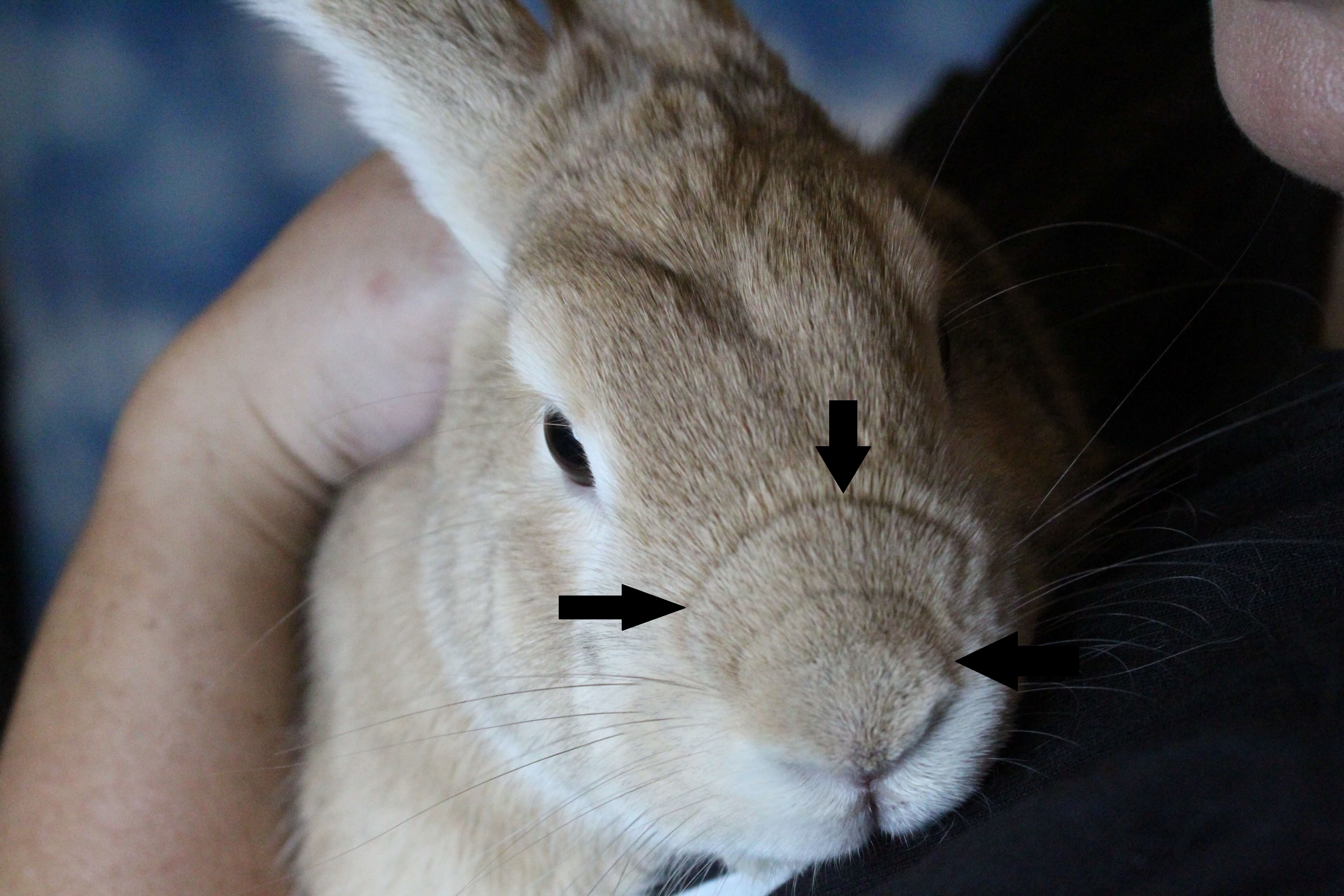 The black arrows show how Harvey's shed lines are stretched across his nose. As his shed continues, the lines will become more pronounced and move further back.
The black arrows show how Harvey's shed lines are stretched across his nose. As his shed continues, the lines will become more pronounced and move further back.Photo by Tim Zerkel
Be aware that a bunny's coat sheds more like a wave. It starts at the nose and moves toward the tail. In some bunnies, you can see a demarcation line along the body which shows where the new and old coat meet.
Often times, bunnies may have a "skirt", which runs along the bottom side and rump of a bunny. It's longer hair that stubbornly holds on. The best way to tackle the skirt is to trim it with scissors or clippers.
One of the most obvious signs a bunny needs a good comb out, are the tufts of fur that stick out like porcupine quills on the back and butt of a bunny. Sometimes these tufts are difficult to remove in one grooming session, especially if the bunny is a Rex or Mini Rex. Although combs are essential tools, often gently pulling out the fur by hand is quicker and more efficient.
Whether you use a comb or hand, bald spots may happen which is fine. This means the old coat is shed before the new one grows in. The new fur should grow in after a week or two.
 Emma is showing off her skirt. It's often easier to just trim the fur off in that area. Emma is showing off her skirt. It's often easier to just trim the fur off in that area. |
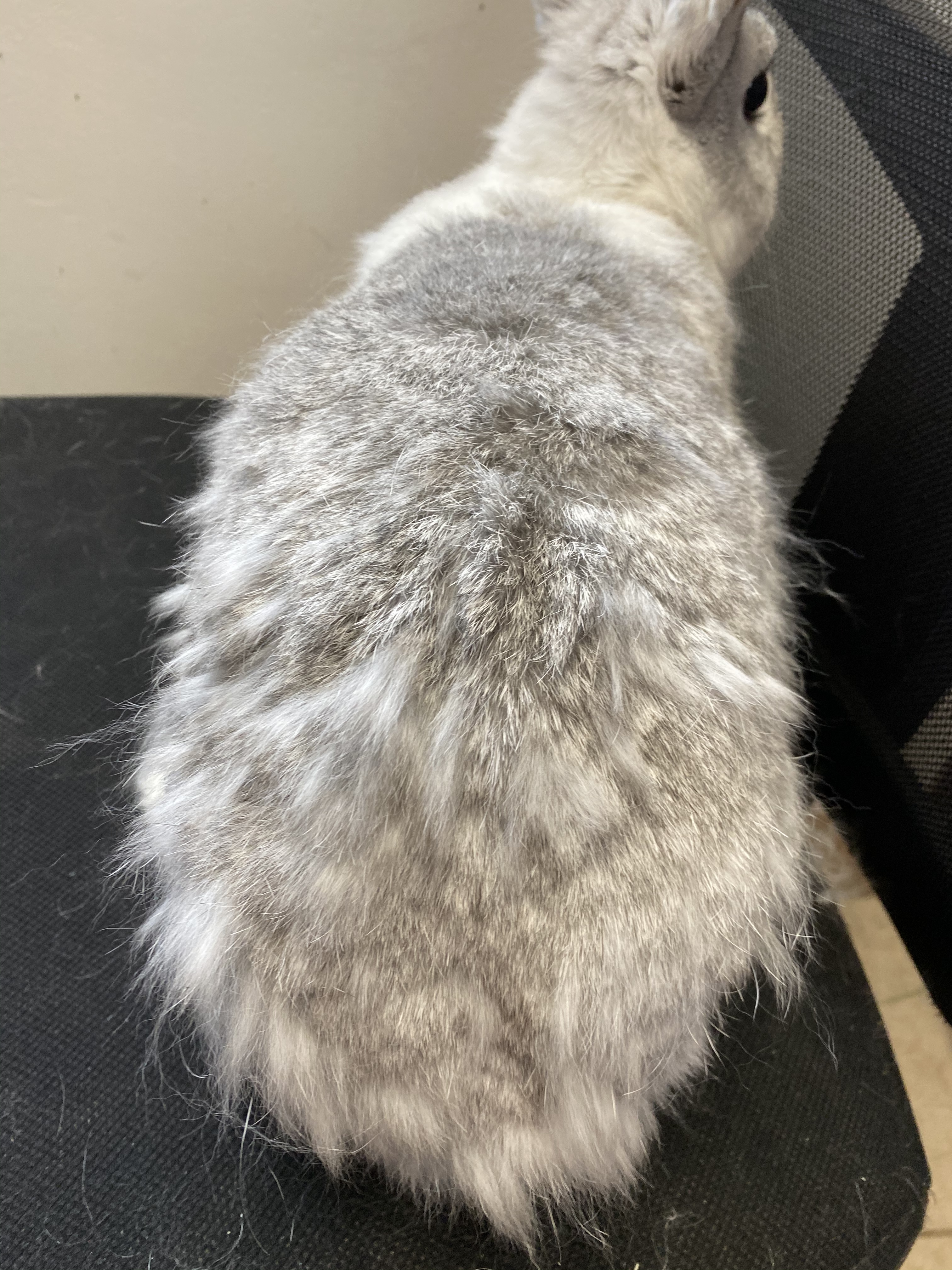 The 'Porcupine Butt'. This will take some time to remove all of the loose fur. The 'Porcupine Butt'. This will take some time to remove all of the loose fur.Photo by Tim Zerkel |
Grooming Rabbits Step-by-Step
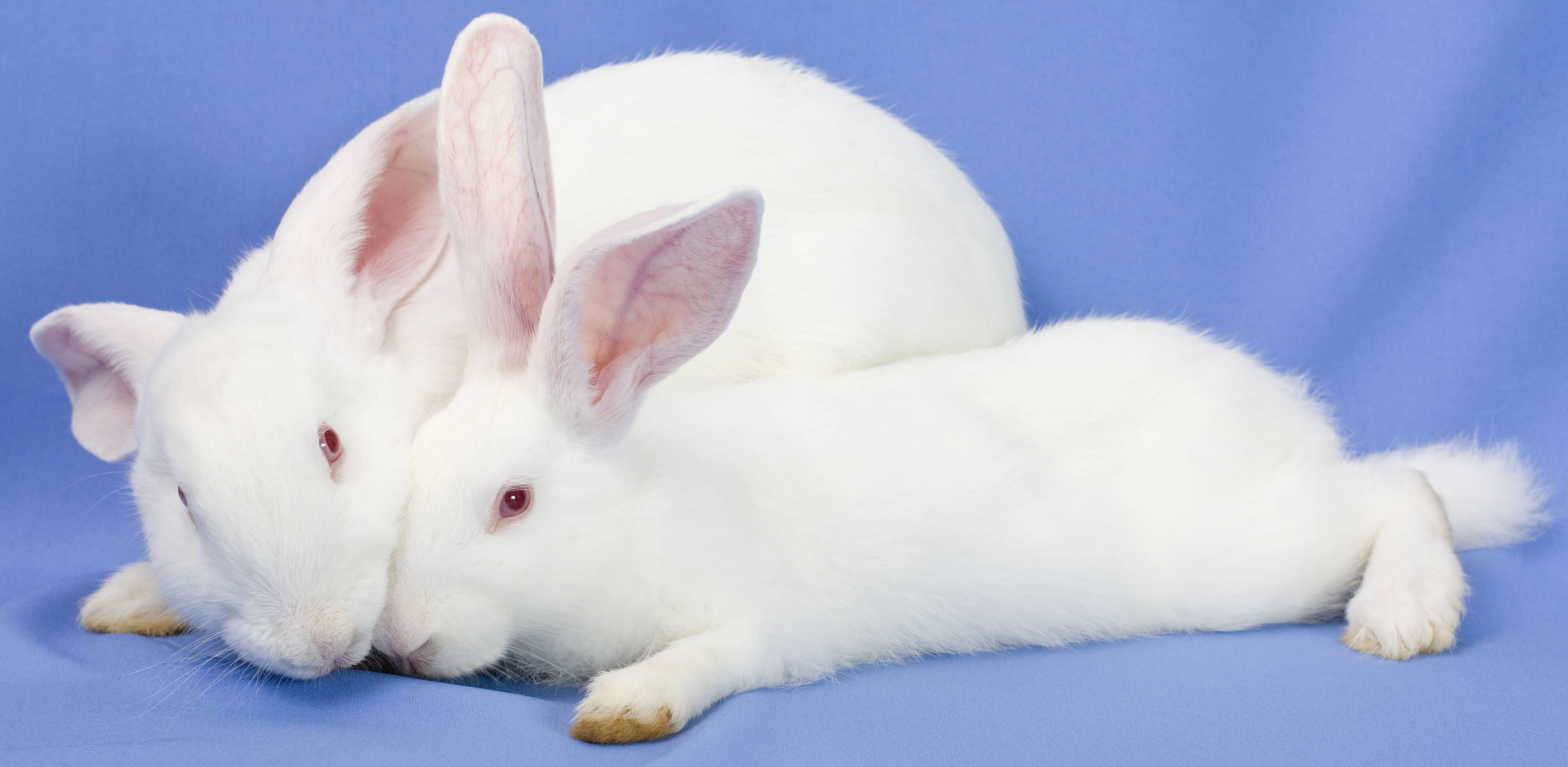 Photo by iava777|Shutterstock.com
Photo by iava777|Shutterstock.comBefore you start, have everything you need within easy reach:
- Large towel
- garbage can
- cotton swabs
- small cup of water (or easy access to the sink)
- grooming tools
1. Set up your grooming station with everything you need.
2. Place a towel on your lap and your bunny on top of the towel. The towel acts like a temporary floor, which will make your bunny feel more secure than just standing on your legs. If your bunny is nervous, spend a few minutes petting and speaking softly to him.
3. While petting your bunny, pay attention to how he feels. Do you feel anything unusual, such as lumps, cuts, swelling or wetness? These kind of changes can indicate dental disease, infections or tumors. Early detection can mitigate these issues.
You will also get to know what is normal for your bunny and when you need to make a vet appointment.
4. Take your flea comb. At a 45 degree angle, start at the tip of the nose and slowly move the comb towards the ears.
Cover one eye with your hand and comb out the cheek. Repeat on the other side. Be careful not to pull out whiskers.
5. Angle the head slightly up and comb the chest. Always keep your comb at a 45 degree angle.
If you are grooming a lionhead, carefully feel for mats in the mane. Often, they form closer to the skin, out of sight.
6. Comb out one side at a time.
From the back of the neck to the tail, work the comb through the fur. If this a heavy shed, you can switch to the hair buster comb and/or you can gently remove some of the tufts by hand. The fur should come out easily. You should not have to use more force than a slight tug. Your rabbit should never be in pain.
Alternatively, for the area around the butt, you can use scissors or clippers to trim the fur. Be sure to use your hand to protect the tail so you don't seriously cut your bunny.
7. Starting from the butt, slowly move your palm up towards the spine. With your other hand, comb the fur as it falls back back into place.
You should see the skin. It should be a light pink. If the skin turns irritated and red, you are overgrooming. Stop and move to a different section.
8. Continue combing the side.
9. Once the one side is completed, turn the bunny 180 degrees and comb out the other side of the bunny.
10. Put your right hand (if you are left handed, do the opposite) on the bunny's chest. The middle finger should be under the left armpit and your thumb should be under the right armpit.
With your right hand, gently push the bunny back towards the crook of the left arm. Your left forearm should secure the bunny against your body.
The bunny should be sitting up and only slightly leaning back. The rabbit should never be flat on his back!
11. Inspect the abdomen, groin, legs, feet and tail for any mats and use the flea comb to comb out. Work on the feet only if there are mats. If it feels like there is a one big mat on the bottom of the foot, leave it. The foot needs some thick fur for protection.
12. Take a cotton swab and dip it in warm water or diluted chlorhexidine solution. Examine the scent glands, located on either side of the anus. A brown, waxy substance builds up in the pocket. If left for a long time, it hardens like dried nasal mucus. Loosen it with a cotton swab soaked in warm water and gently wipe the skin clean. This area is very delicate, so take your time and don't be aggressive.
13. Trim nails.
For more details on how to trim nails, click here.
14. Once all the nails are trimmed, gently guide the bunny back to his initial position with all four feet on your lap. Use the finishing brush on the back and sides of the bunny to remove any loose hair that may have settled on top of the coat. Alternatively, you can wet your hands and run them along the bunny's body.
15. Finished! Give your bunny a treat!
Grooming Rabbits Do's and Don'ts
Never:
- Bathe a bunny! This can result in shock, hyperthermia and death. There are certain exceptions where bathing is necessary, which is explained further in the Special Needs section of this website.
Trance your bunny: Trancing (or tonic immobility) is when a bunny is flat on his back, feet in the air and very still. This is a fear response that kicks in when a rabbit is cornered by a predator. Heart and respiration rate also decreases, which may be disastrous if your bunny is elderly or has heart and lung conditions. Always make sure your bunny is sitting up as much as possible.
Use flea medication without consulting your veterinarian. Many brands are dangerous to rabbits (such as Frontline). Revolution is commonly used for rabbits, but available as prescription only. Do not use flea shampoos, flea bombs or flea powders.
Remove crusts in ears. Thick crusts indicate ear mites which need to be treated with medication. Do not pick at it or try to remove it as it is very painful and the ear will bleed.- Overly stress your bunny. If your bunny is high-strung and panics during handling, just trim the nails and leave the rest. Signs that your bunny is panicking: constant bulging eyes, yawning, gasping and excessive pooping. For these kinds of bunnies, I never sit them up and I push their nail trims to every 12 weeks.
Trim your rabbit's teeth. Only the front upper and lower incisors and peg teeth are easily visible. Ideally, the teeth should be straight across, but sometimes they may be crooked. That's fine as long as the teeth still grind themselves down. If they do not line up at all, the teeth will continue to grow and interfere with eating. if you notice misaligned teeth, please schedule a vet visit as soon as possible. Do not use nail clippers, pliers, etc. to trim them! You can easily remove portions of the cheek, tongue or lips. A greater danger is if the tooth splits down to the root. This will result in a major surgery to repair the damage.
 Sprinkles with his brother Cupcake.
Sprinkles with his brother Cupcake.Do:
- Take your time. This can be a great bonding session between you and your rabbit.
Make sure you're relaxed. Petting your bunny and giving him a mini-massage is a good way to relax your bun. What does he likes best - cheek rubs, ear massages, nose rubs?
Be confident. Rabbits know when you are nervous. It puts them on edge and makes them look for a way out.
Give them a treat at the end. Let them know that grooming isn't the worst thing in the world.






